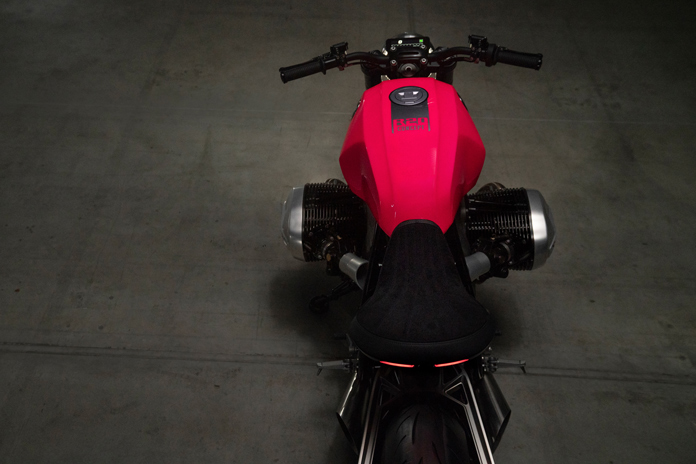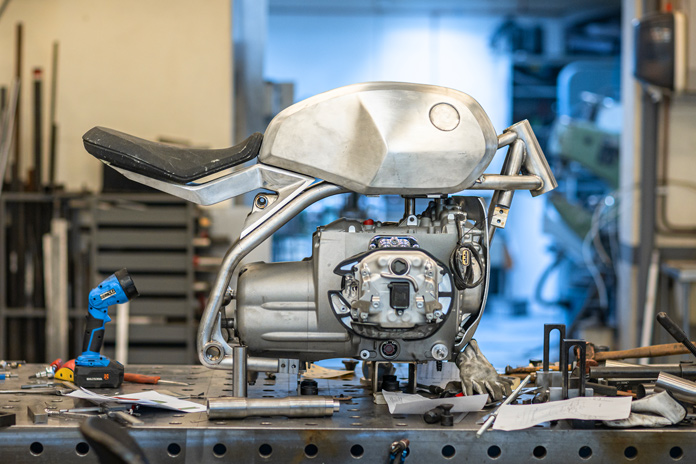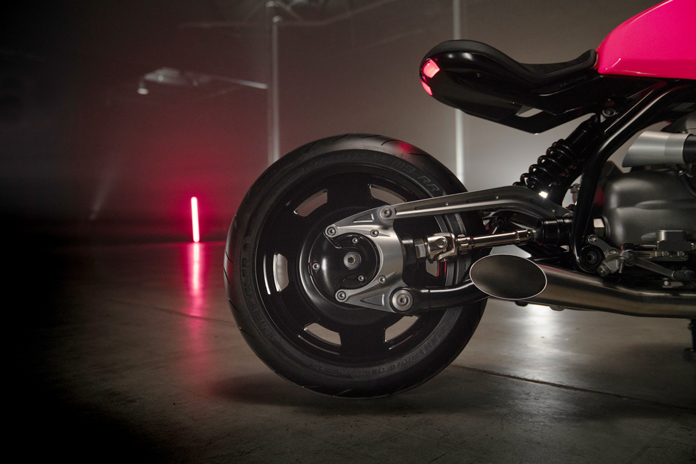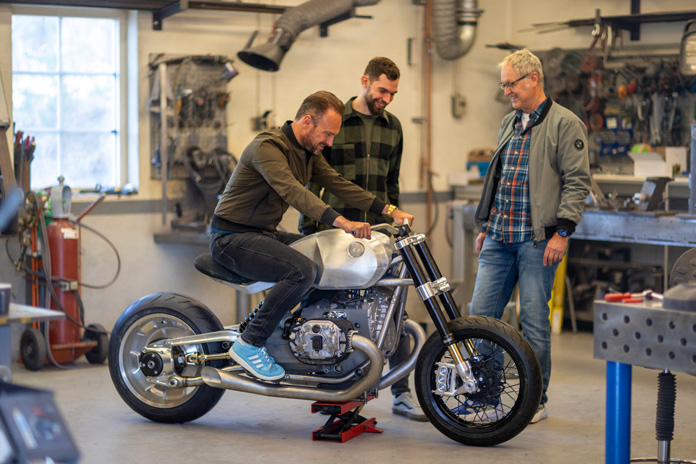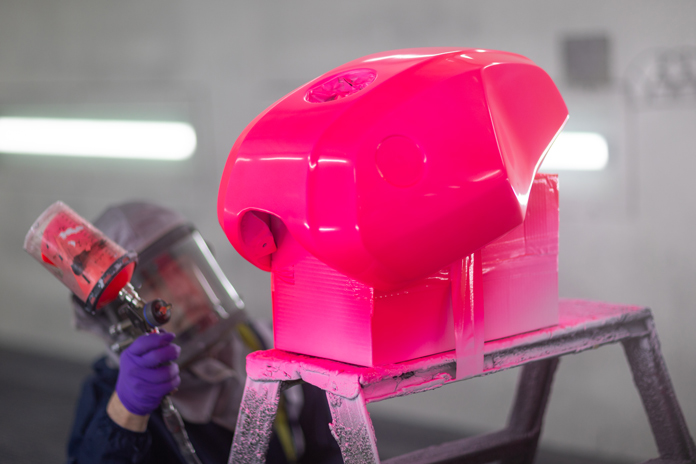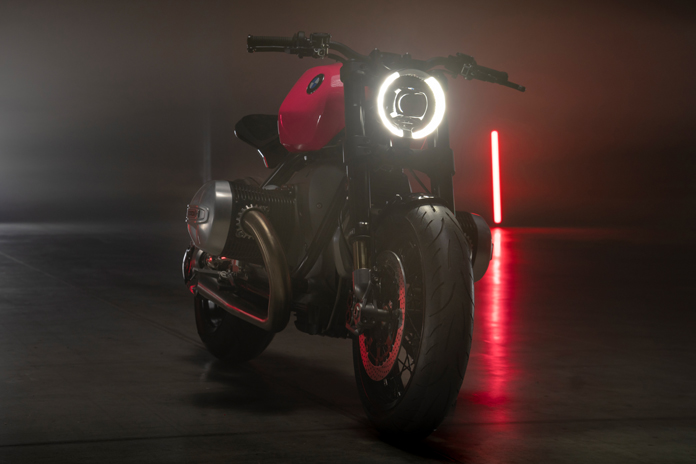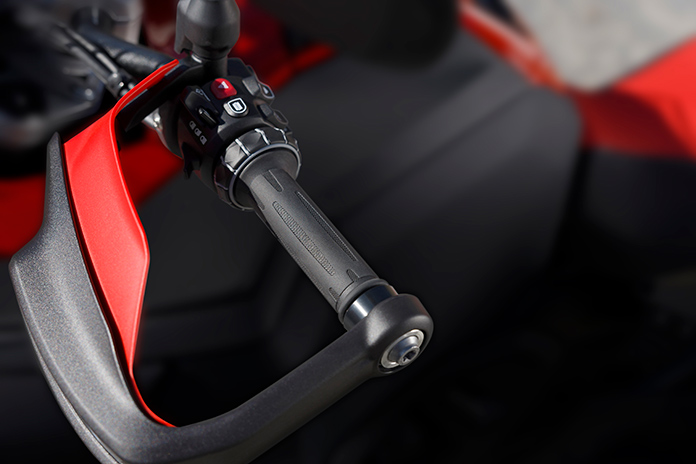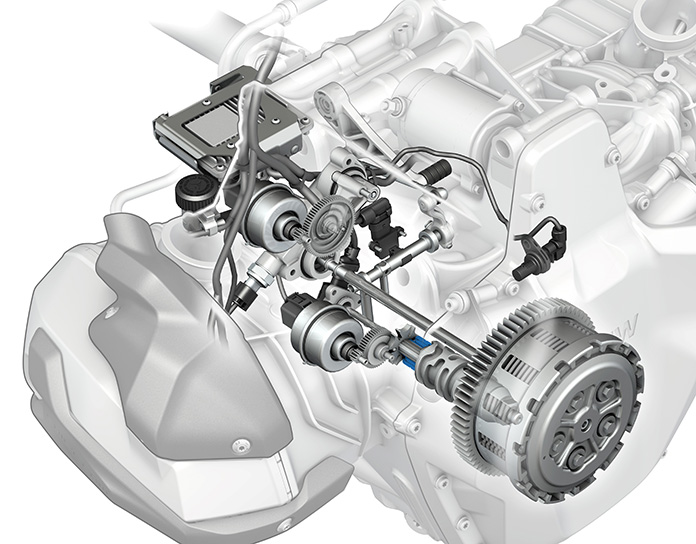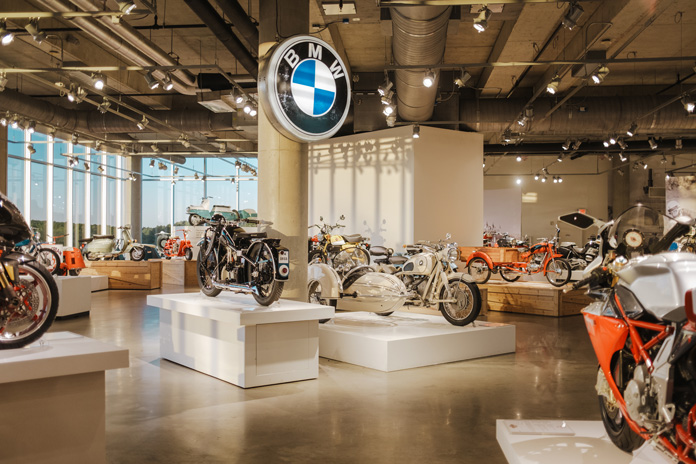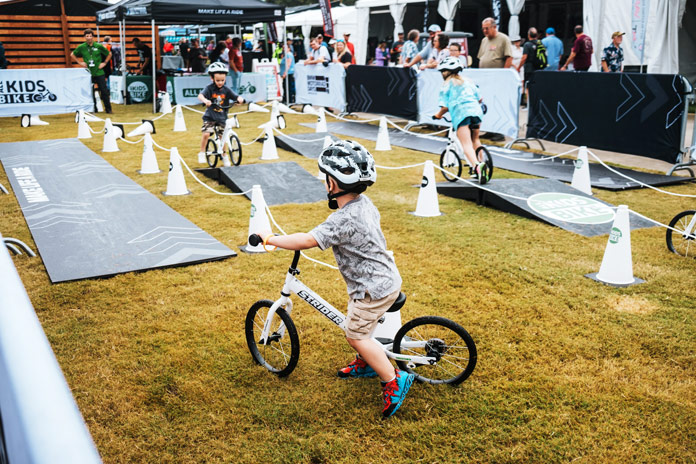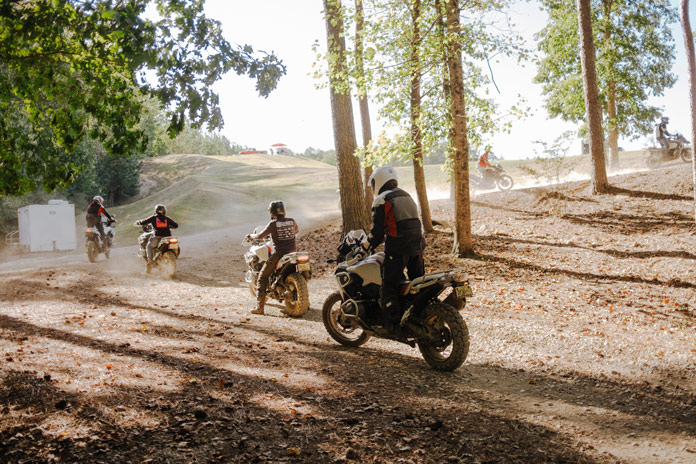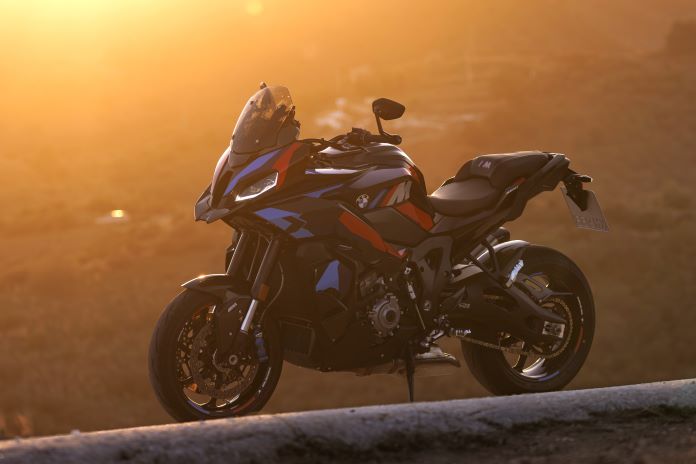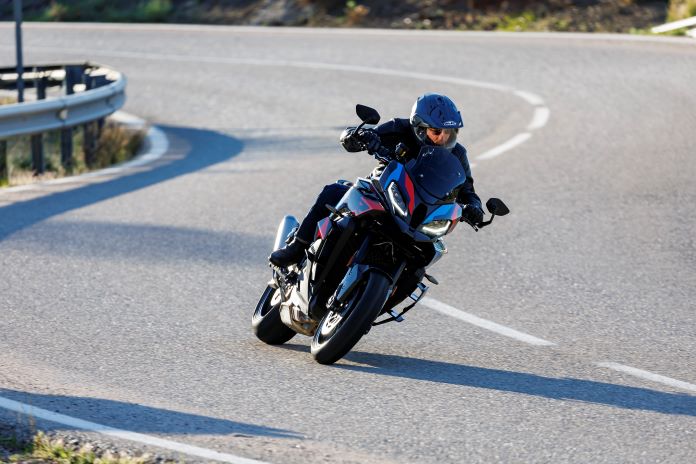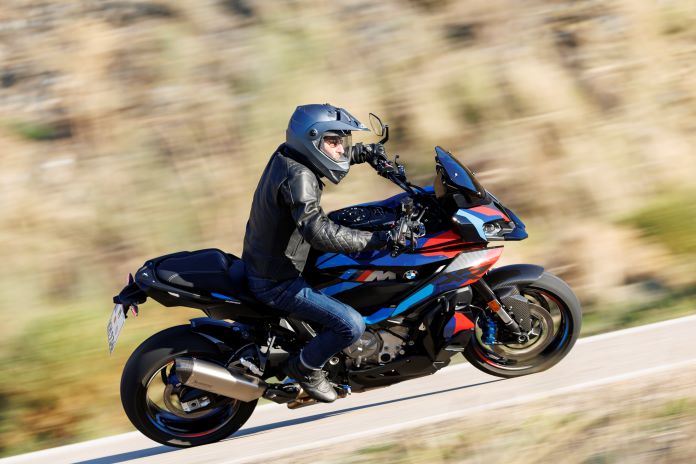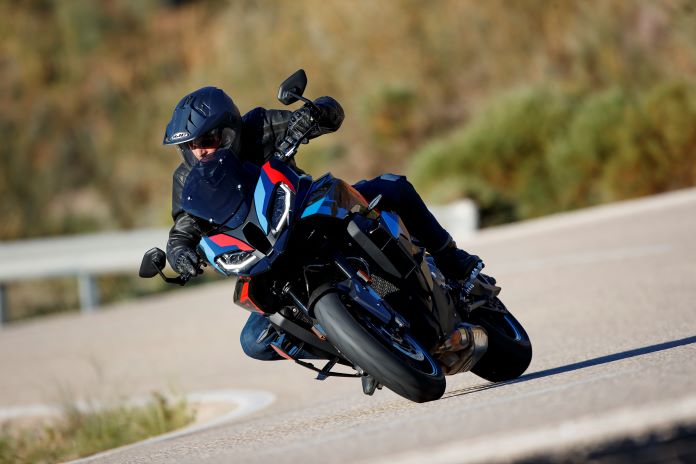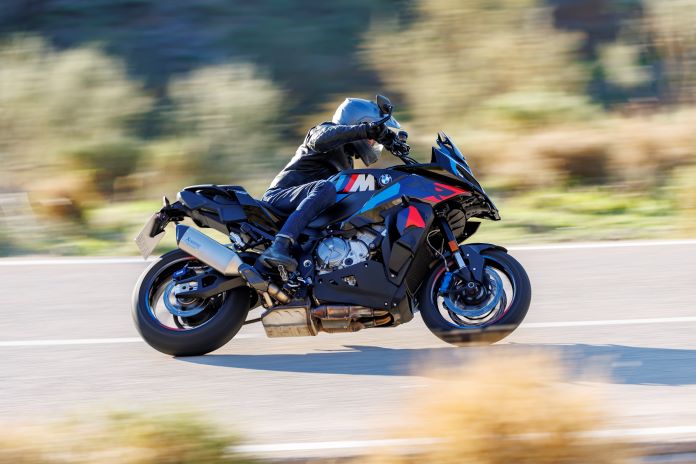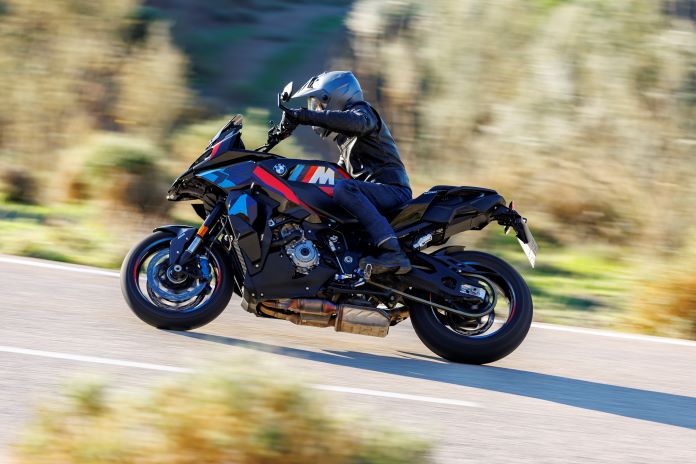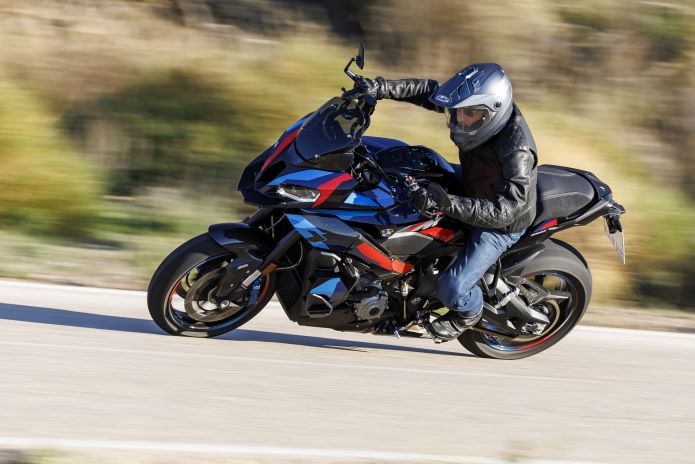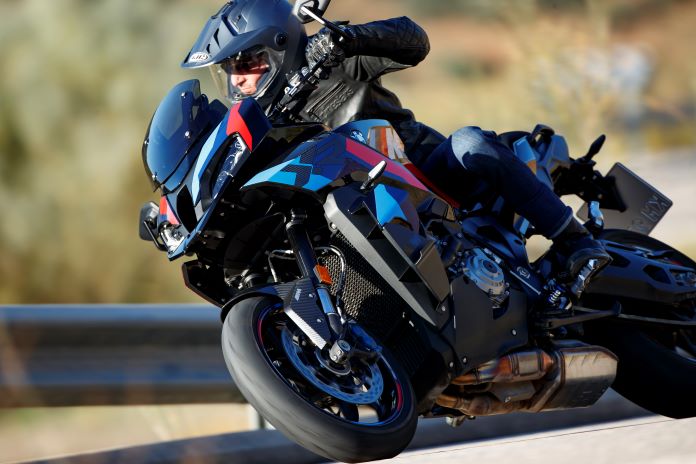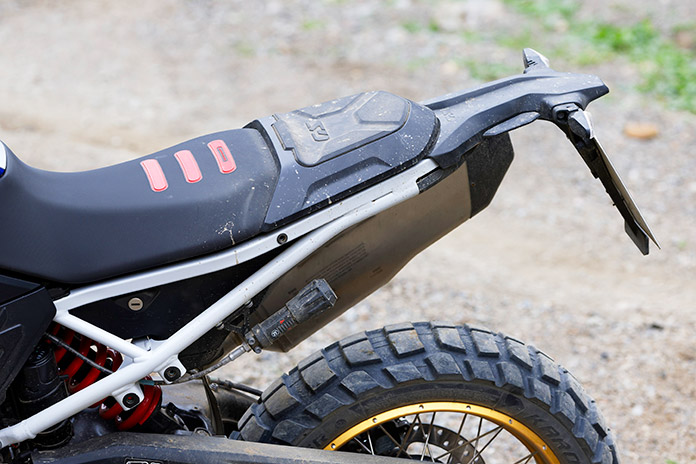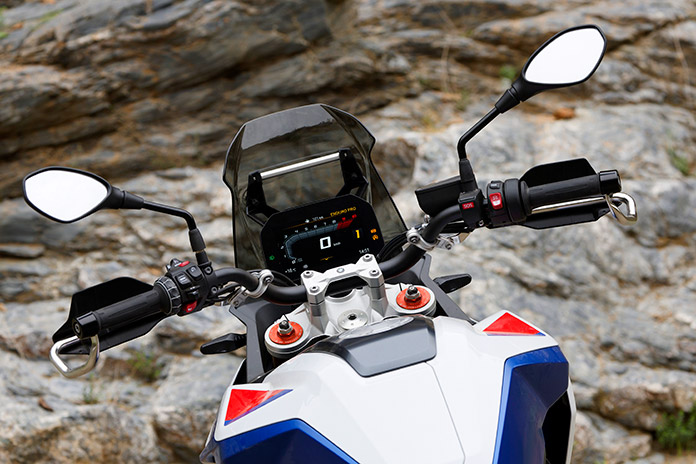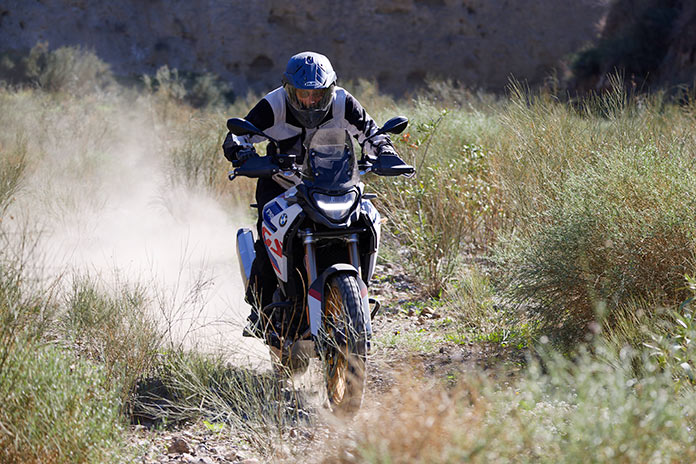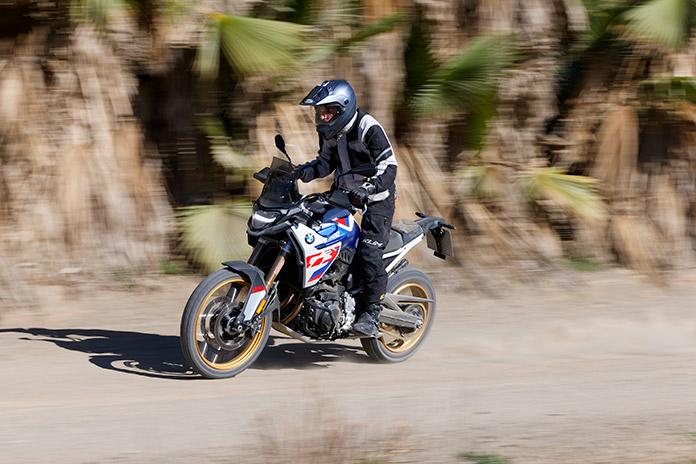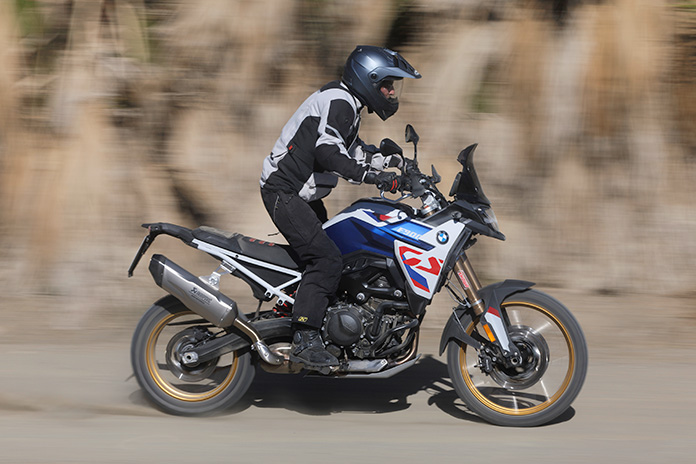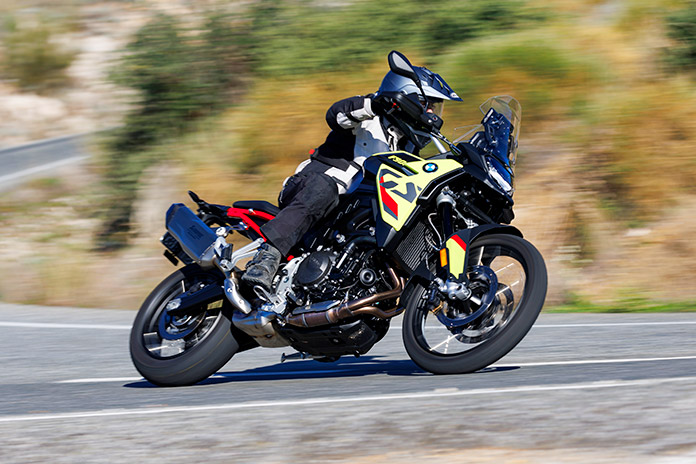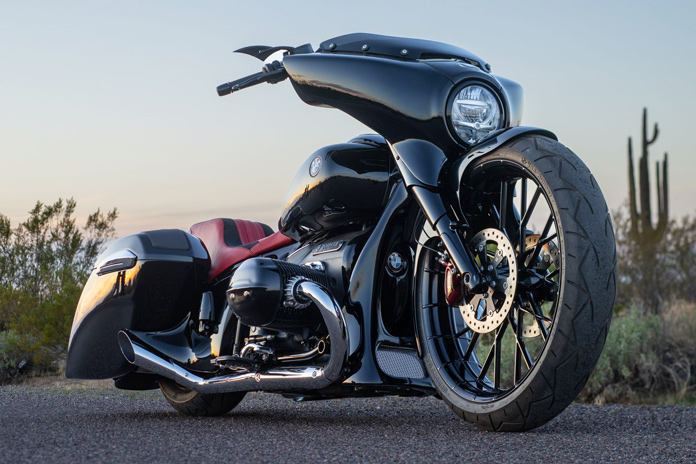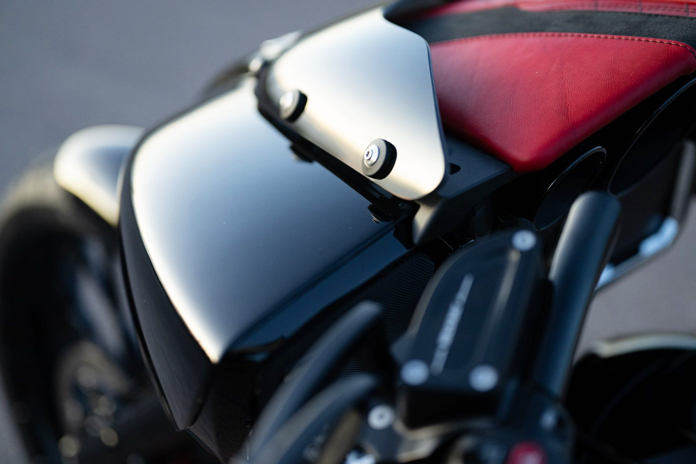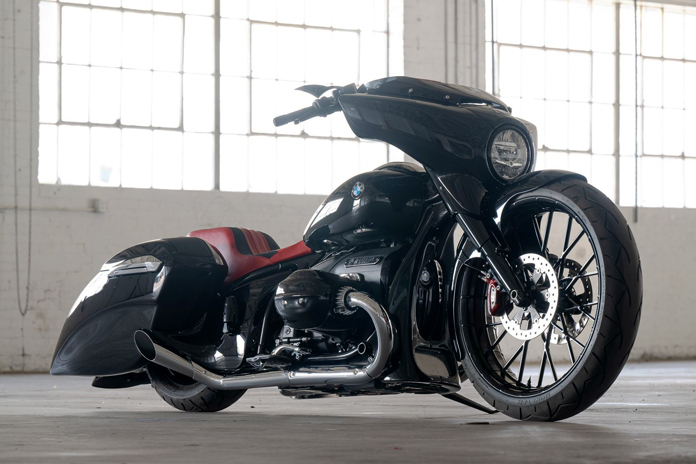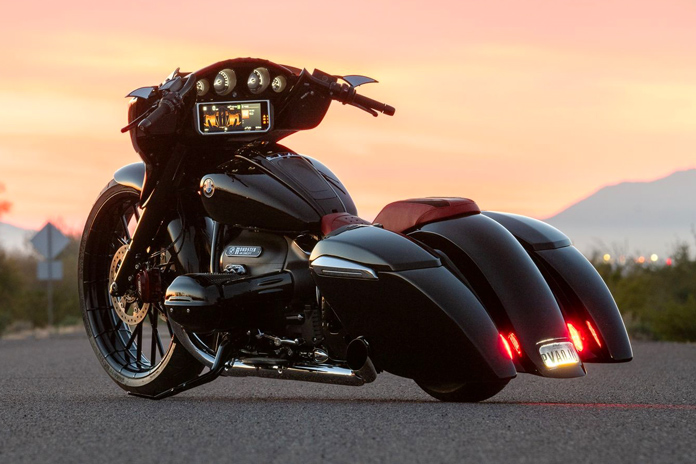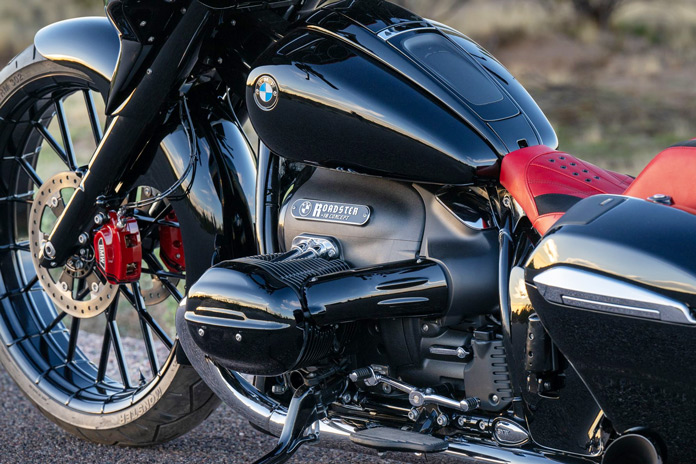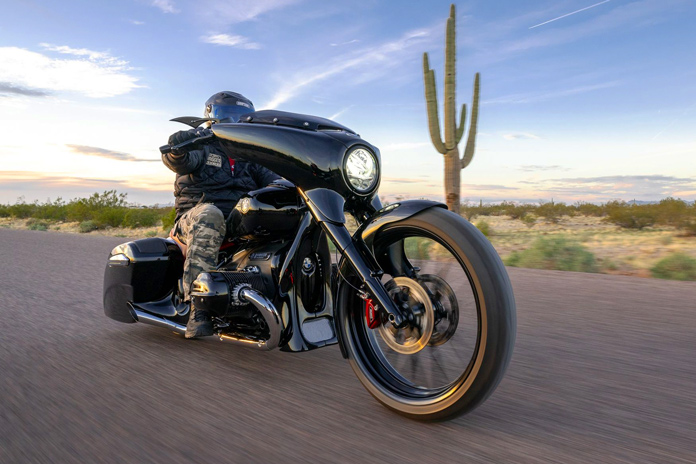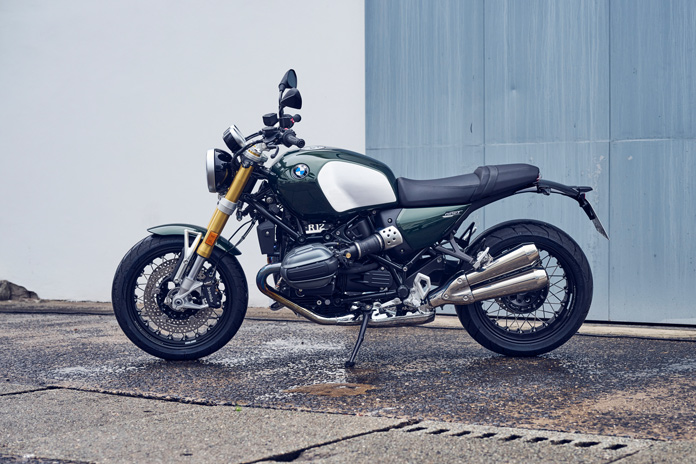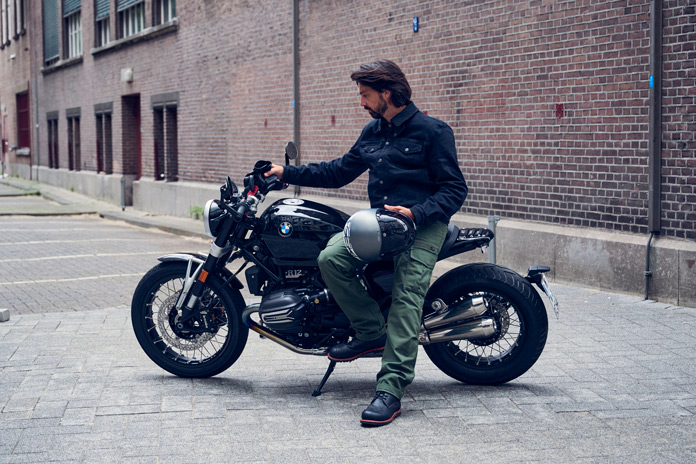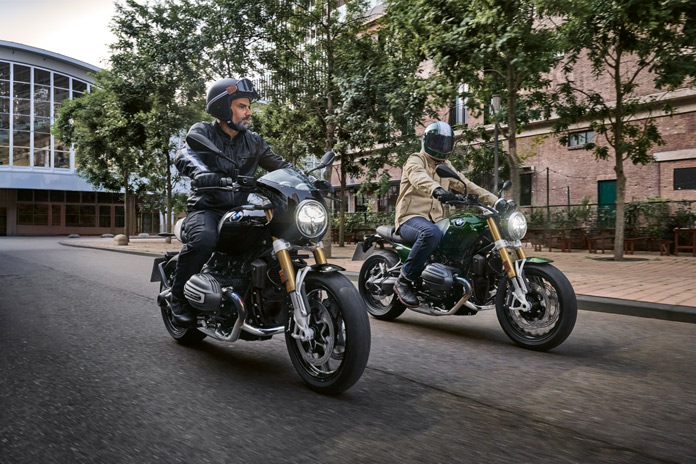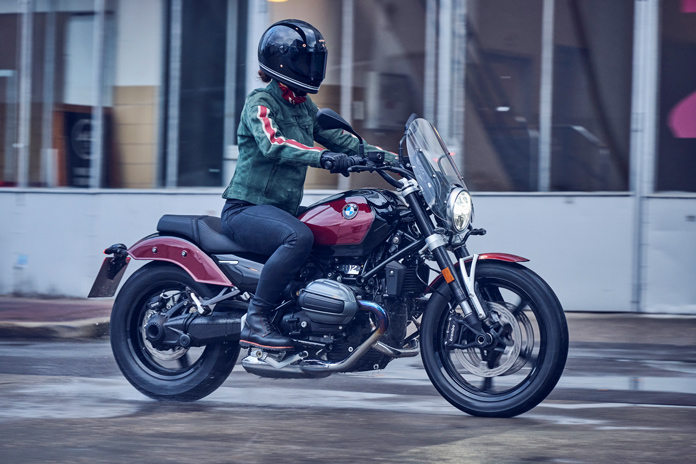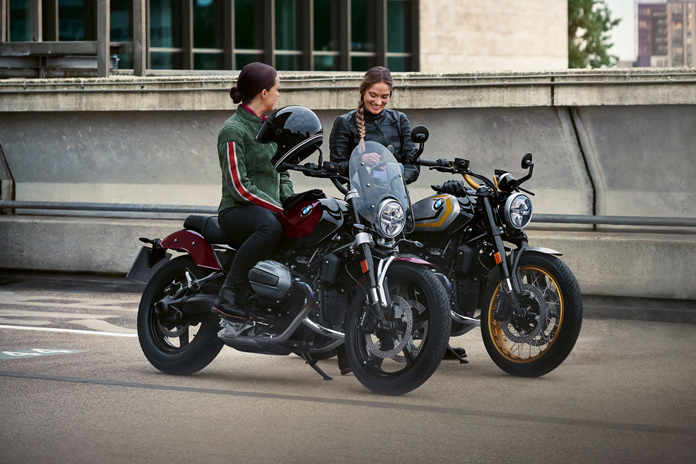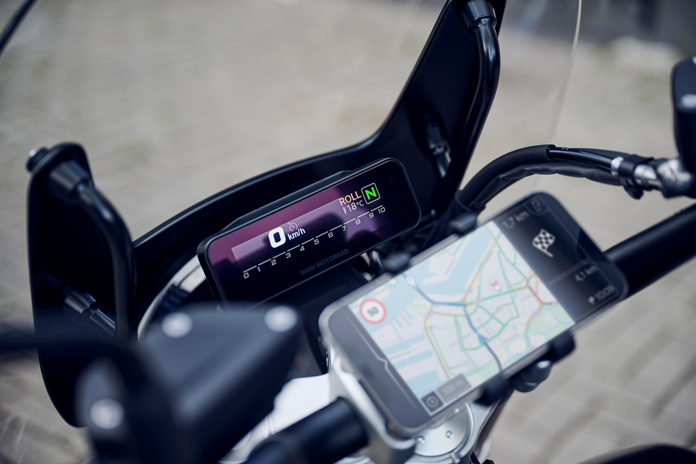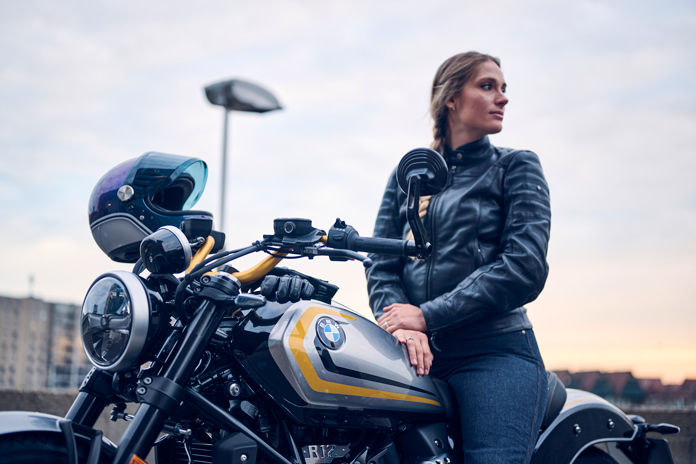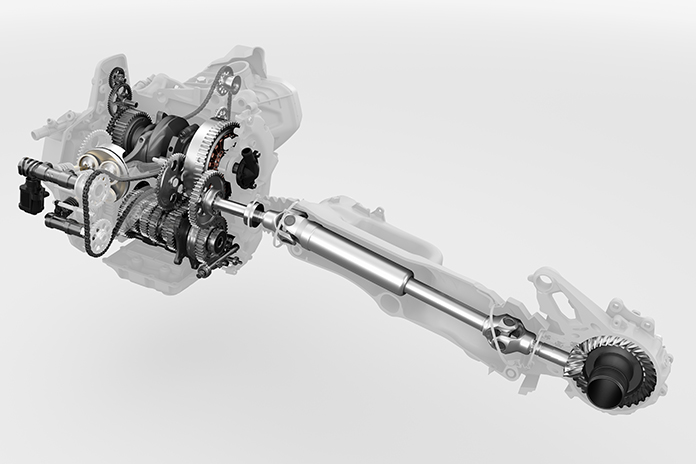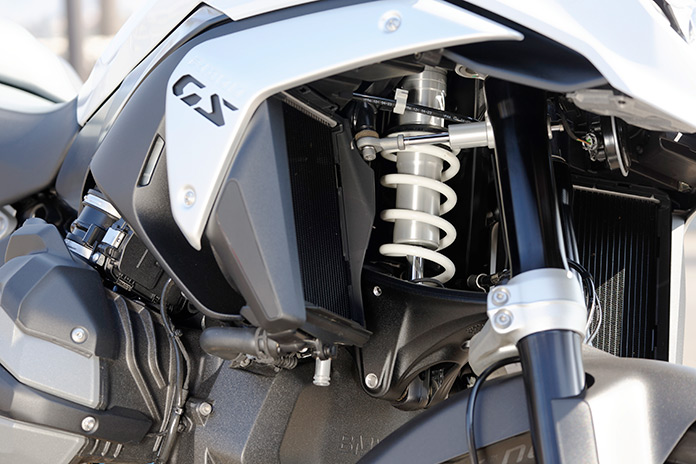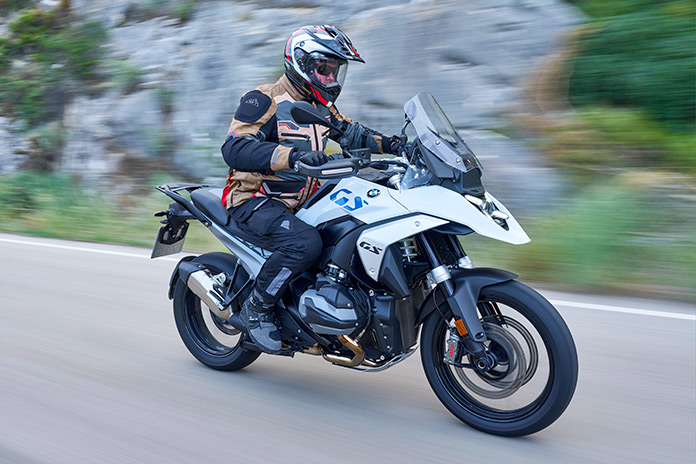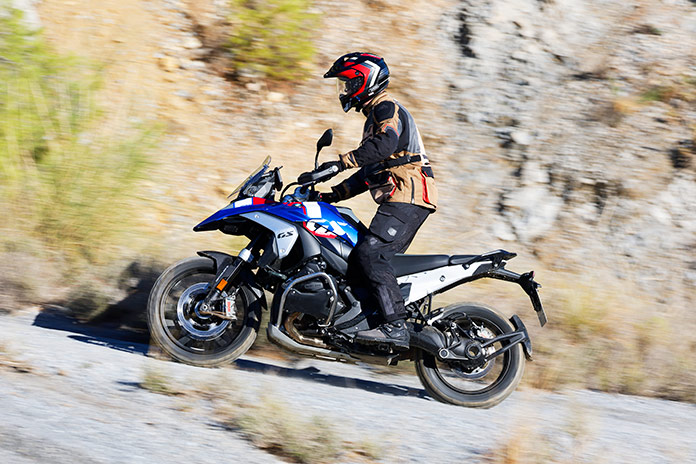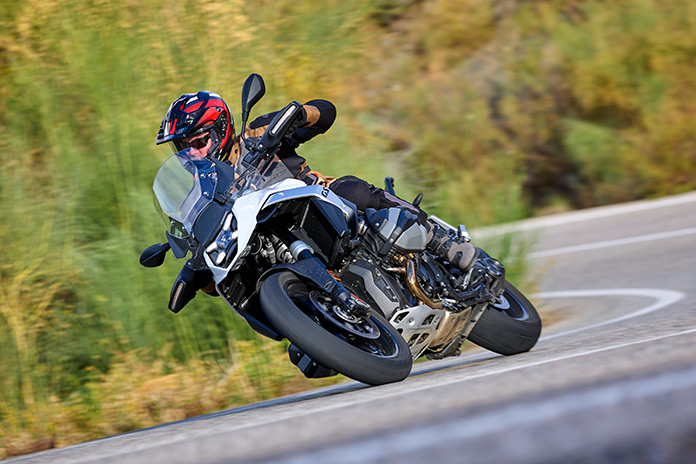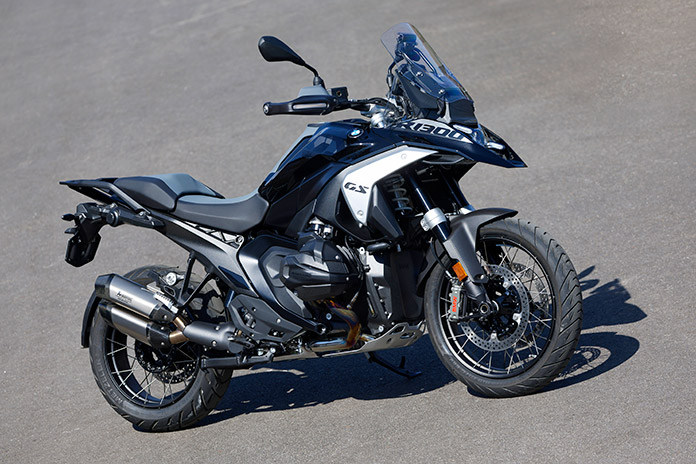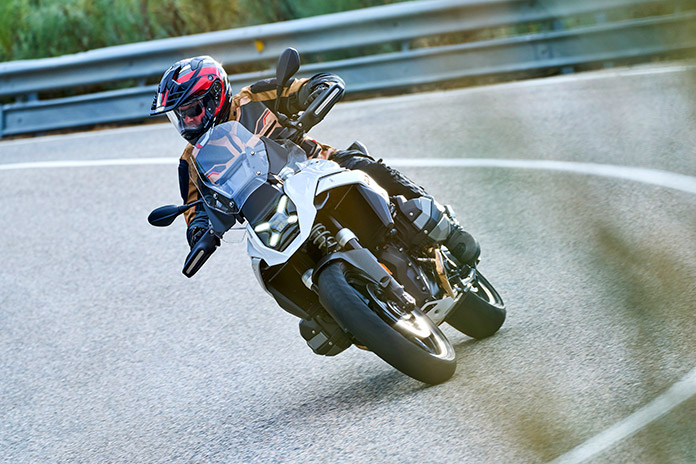The post BMW R20 Concept Unveiled appeared first on Rider Magazine.
]]>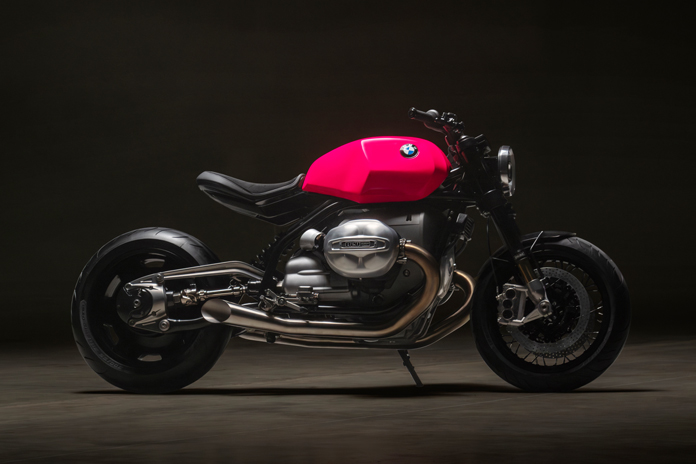
BMW Motorrad unveiled the BMW R20 concept bike at the Concorso d’Eleganza Villa d’Este show in Italy. The R20 features a classic roadster design paired with sophisticated components and a minimalist style, showcasing the air/oil-cooled Big Boxer engine as its centerpiece.
The BMW R20 is an eye-catching motorcycle, with a “hotter than pink” pop of color on the aluminum tank. The bike has been designed to highlight the 2,000cc boxer engine, with its massive cylinders jutting out horizontally, and new components – cylinder head covers, belt cover, and oil cooler – were developed for this concept.
Related: Paul Yaffe Creates Custom BMW R 18 One Eight “C”
The bike’s double-loop main frame is made of chromoly steel tubes, and the R20 features a new dual-sided variant of BMW’s Paralever system. In this new variant, the swingarm is made of chromoly steel, and the strut is aluminum. The exposed driveshaft adopted from the R 18 has been shortened, and the bike rides on 17-inch wheels, with a spoked wheel up front and a black disc wheel in the rear.
Related: BMW R 18 Roctane Review
Suspension components are provided by Öhlins, the rake is 27.5 degrees, and the wheelbase is 61 inches. Radial-mounted ISR brakes feature a pair of 6-piston front calipers and a single 4-piston rear caliper.
Adding to the R20’s sophisticated look, the taillight is integrated into the single seat upholstered with quilted black Alcantara and fine-grain leather, and the rear has a compact, uncluttered appearance. The LED headlight is surrounded by an aluminum ring with integrated daytime running light, with the main headlight appearing the float within the ring.
“The R20 concept is a bold interpretation of the BMW Motorrad DNA,” says Alexander Buckan, head of design for BMW Motorrad. “It combines modern technical elements with a classic roadster design. Its oversized proportions and minimalistic aesthetic make it an unmistakable character.”
Find more information about the R20 and other BMW models at the BMW Motorrad website.
Check out more new bikes in Rider’s 2024 Motorcycle Buyers Guide
The post BMW R20 Concept Unveiled appeared first on Rider Magazine.
]]>The post BMW Motorrad Unveils Automated Shift Assistant appeared first on Rider Magazine.
]]>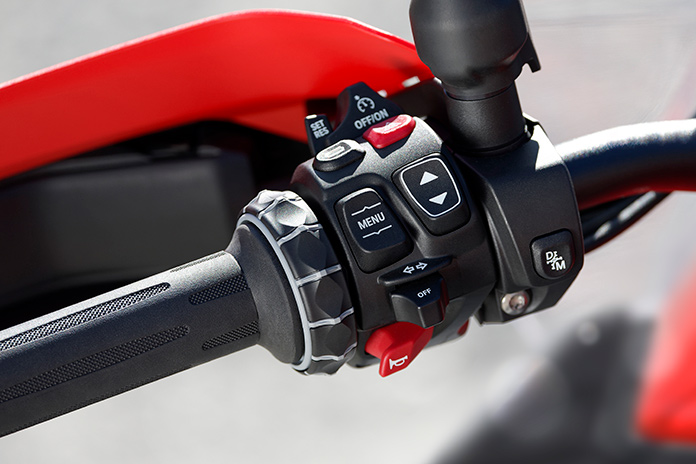
Motorcycles equipped with quickshifters, which allow upshifts and downshifts without using the clutch, have become commonplace in the last few years. The BMW Motorrad Shift Assistant Pro is an optional quickshifter on many BMW models, including the new R 1300 GS, the M 1000 XR, and many others. Even with a quickshifter, riders must use the clutch to pull away from a stop. BMW’s new Automated Shift Assistant eliminates the need to use the clutch at all, and it will be an option on R-series models powered by boxer Twin engines. Read the full press release below.
With the new Automated Shift Assistant (ASA), BMW Motorrad presents an innovative technical solution that makes riding simpler and more comfortable. True to the motto “Simplify your ride,” the riding experience is enhanced by automation of the clutch and gear shifting process, without sacrificing the emotionally important dynamics of shifting.
The Automated Shift Assistant features a clever functional design in which two electromechanical actuators automate the clutch and gearshift of the six-speed transmission, which is the main difference to a conventional shift assistant. There is no need for a hand lever to operate the clutch manually. Starting, stopping, and maneuvering are all made easy with the Automated Shift Assistant.
Riding with the Automated Shift Assistant becomes more enjoyable thanks to fast, precise, rev- and load-adapted gear changes. The rider’s workload is reduced, which makes riding more enjoyable. In addition, the Automated Shift Assistant creates a more direct connection with the powerful boxer engine, as the precise clutch actuation makes it easier to control the riding experience via the throttle and gearshift lever.
In ‘M’ shift mode, gear changes can still be made by foot control, allowing the rider to decide when to change gears.
In ‘D’ shift mode, the Automatic Shift Assistant really comes into its own. Shift points are automatically selected by the engine control unit. In both “M” and “D” modes, the rider benefits from smooth and perfectly executed gear changes, resulting in efficient motorcycle acceleration and increased riding stability.
When shifting up, for example, the possible jolt associated with a classic manual transmission with a manual clutch is largely eliminated, as is the risk of helmet-to-helmet contact between rider and passenger.
Downshifts are also designed to be as smooth as possible, minimizing chassis disturbances. Specific characteristics of the automated shift function are assigned to the different riding modes to ensure perfect shift behavior in each riding situation. In combination with Active Cruise Control or front collision warning, the networking of functions brings the future of motorcycling to life.
Automated Shift Assistant: Automated clutch and gear shifting for a new riding experience.
In difficult riding situations, using the clutch and throttle takes a lot of concentration. If you are travelling with luggage and perhaps a passenger, using the clutch and gearshift takes up resources. The rider remains in control and has more freedom in every riding situation with the Automated Shift Assistant. Riding becomes a more relaxed and enjoyable experience.
The torquey boxer engine enables almost effortless starts on uphill gradients, for example, thanks to automated clutch operation, which also pays dividends in terms of better vehicle control off-road or on difficult surfaces.
Riding pleasure takes on a whole new meaning when you choose the automated D mode. Optimally selected gear changes create a new riding sensation. The right gear is automatically selected according to the rider’s individual riding needs, resulting in a harmonious and extremely smooth driving experience.
Automated Shift Assistant: Electromechanical clutch and gearshift actuators combined with sophisticated electronic controls.
The Automated Shift Assistant is the logical and technical evolution of the BMW Motorrad Shift Assistant Pro. Two electronically controlled electromechanical actuators operate the clutch and gearshift, enabling easy starting and automated gear changes. The rider’s shift request is transmitted to the control unit via a gearshift lever sensor, which is actuated by the conventional foot-operated gearshift lever. Additional sensors determine the revs of the transmission input shaft and the clutch position. These values are transmitted to the
TCU (Transmission Control Unit), which is closely linked to the engine control unit, for control of the clutch and shift actuation.
The clutch is operated by an electro-mechanical actuator combined with a hydraulic system with a direct hydraulic connection between the clutch master and slave cylinders. The actuator regulates the required clutch slip, engages the clutch when changing gear and disengages it when stopping.
In manual shift mode “M”, the rider can move the gearshift lever in the desired direction in the usual way. If the revs in the desired target gear are within the maximum or minimum rev range, the shift is made directly. If the engine revs fall below a gear- dependent minimum speed, downshifts are performed automatically in manual mode. This prevents the engine from stalling.
In shift mode “D” the gears are changed automatically depending on the riding mode, engine revs, throttle position and lean angle parameters. Gears are shifted according to the riding situation and dynamic requirements.
The benefits of the Automatic Shift Assistant (ASA):
- Completely eliminates the need for the rider to operate the clutch.
- Dynamic and comfortable gear changes for more riding pleasure.
- Choice of manual or automatic gear shifting.
- Automatically adapts gear shifts to the rider’s dynamic preferences in D mode.
- Eliminates the possibility of engine stalling during gear shifts.
Check out the latest bikes in Rider’s 2024 Motorcycle Buyers Guide
The post BMW Motorrad Unveils Automated Shift Assistant appeared first on Rider Magazine.
]]>The post BMW Motorrad Days Americas Returns to Barber Vintage Festival, Oct. 11-13, 2024 appeared first on Rider Magazine.
]]>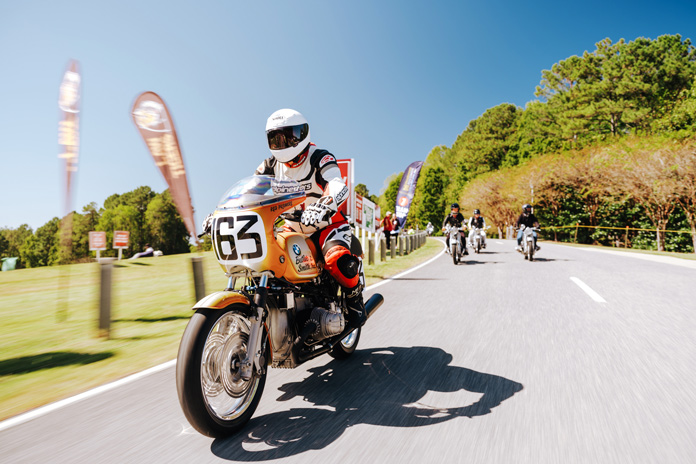
After a successful inaugural BMW Motorrad Days Americas last year, the event will return to Alabama for the 2024 Barber Vintage Festival on October 11-13.
Related: Inaugural BMW Motorrad Days Americas at Barber Vintage Festival a Success
The 2023 event, also held during Barber Vintage Festival, celebrated the 100th anniversary of BMW Motorrad. BMW motorcycle enthusiasts from across the country traveled to Barber Motorsports Park to enjoy the festivities, demo ride BMW motorcycles, and connect with other BMW riders.
“Last year’s celebration of the BMW Motorrad Days Americas at the Barber Vintage Festival was so much fun, there is no way we could not be back,” said Luciana Francisco, head of marketing and product for BMW Motorrad USA. “There is no better community than the global motorcycling community, and we could not ask for a better host than the Barber Vintage Festival. Seeing so many people, from so many different backgrounds, together, celebrating our passion for riding, is truly a special experience.”
The BMW Motorrad Days Americas will include the BMW Motorrad Fan Zone with new and vintage motorcycles, a kid zone, live music, a biergarten, and a great view of vintage racing on the Barber circuit. There will also be on- and off-road demo rides of the newest BMW models, like the R 1300 GS, F 900 GS, R 12, and CE 02.
Related: 2024 BMW R 1300 GS Review | First Ride
Related: 2024 BMW F 900 GS Review | First Ride
Related: 2024 BMW R 12 nineT and R 12 Review | First Look
Related: 2024 BMW CE 02 Review | First Look
“I couldn’t be more thrilled to announce the return of BMW Motorrad Days to the Barber Vintage Festival, said George Dennis, President of ZOOM Motorsports. “It’s a celebration of passion, performance, and the vibrant community that fuels our love for two-wheel adventures.”
Tickets for the Barber Vintage Festival will go on sale on May 21, and those who purchase event passes through BMW Motorad USA will access ticket discounts.
Visit the BMW Motorrad website or the Barber Museum website for more information and to purchase tickets when they go on sale.
The post BMW Motorrad Days Americas Returns to Barber Vintage Festival, Oct. 11-13, 2024 appeared first on Rider Magazine.
]]>The post 2024 BMW M 1000 XR Review | First Ride appeared first on Rider Magazine.
]]>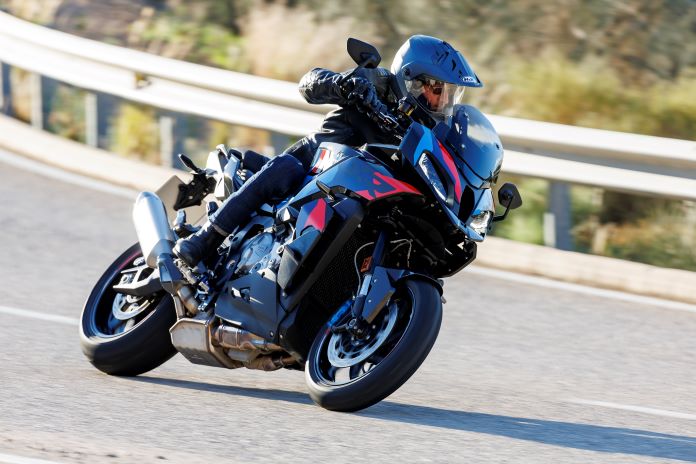
BMW’s lineup of streetbikes is amazingly diverse, from single-cylinder roadsters all the way up to the supersized R 18 series, so there’s a Beemer for almost anyone. BMW’s all-conquering GS series attracts most of the headlines, but there’s another gem often hidden in the shadows.
The S 1000 XR was one of the first sporty adventure-tourers on the market, eschewing off-road capability for street performance but with a longer-travel suspension than typical sportbikes. Introduced in 2015, the partially faired XR was based on the S 1000 R roadster using the mighty 999cc inline-Four from the S 1000 RR superbike.
Related: 2020 BMW S 1000 XR | Tour Test Review
Related: 2023 BMW S 1000 RR and M 1000 R | First Ride Review
BMW described the XR as an “Adventure Sport Bike,” while we see it as a high-performance sport-touring bike. Whatever term you prefer, the XR has been an outrageously fast way to carve up interstate maps with squiggly lines.
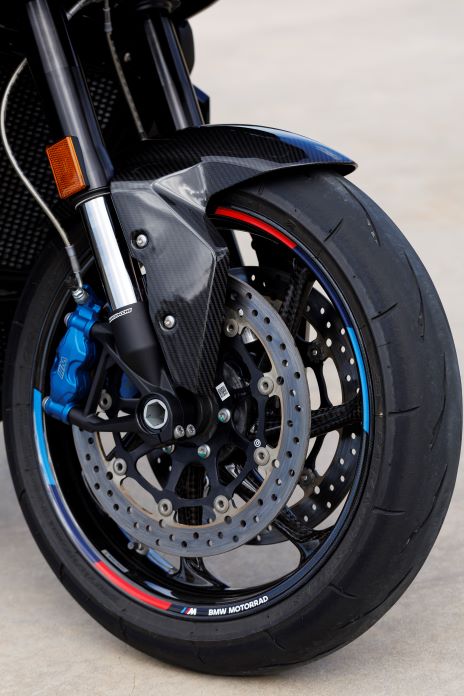
But when it comes to performance, there’s always a slice of the market that desires the utmost in speed, which is where this new M 1000 XR comes in. Boasting a seriously stout 201 hp, the M version of the XR takes the adventure sportbike theme to a stratospheric level.
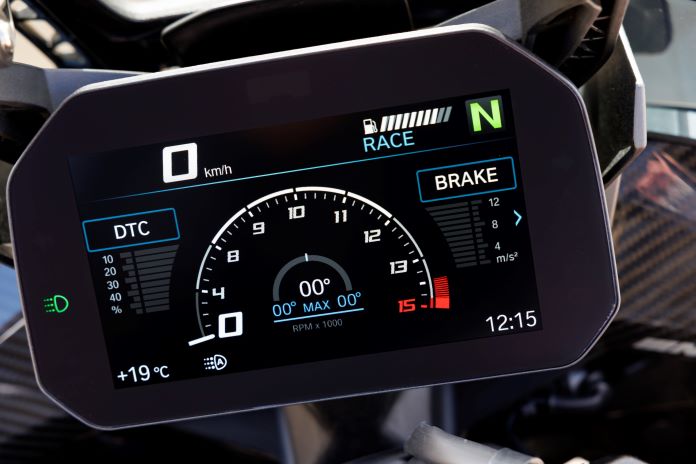
“It’s like a racebike with benefits of a crossover,” BMW proclaimed at the M 1000 XR’s recent launch in Spain. Motorrad reps say it’s the lightest and most powerful crossover bike on the market, intended to rule the roost of bikes designed for long-distance high-performance.
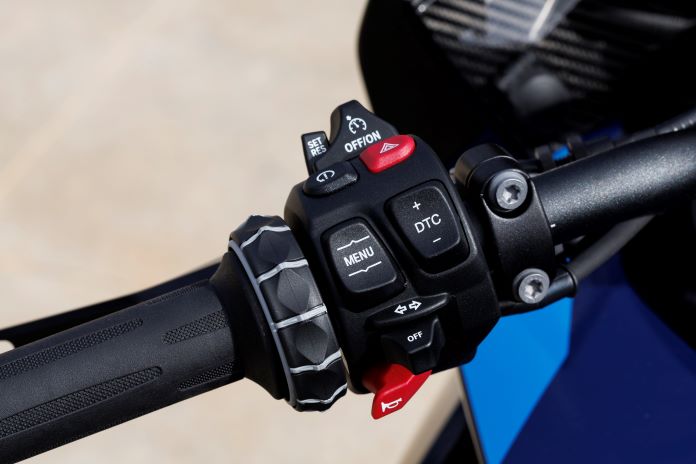
The S 1000 XR was also updated for 2024, gaining 5 hp to 170 ponies and now retailing for $18,190. But our focus was on the M version, the third M model from BMW Motorrad following the M 1000 RR superbike and the M 1000 R roadster. The S 1000 XR has a curb weight of 500 lb, 8 lb more than the M-XR.
Related: 2023 BMW S 1000 RR and M 1000 R | First Ride Review

Design | BMW M 1000 XR
The XR still has a vestigial beak at its nose like ADVs do, but that’s as close to an adventure bike as the XR gets. Instead of a big schnoz masquerading as a front fender, the M 1000 XR has MotoGP-like winglets along the sides of its fairing.
BMW says the wings generate 41 lb of downforce at the M-XR’s 171-mph top speed, dropping to 25 lb at 137 mph. Probably a negligible amount at highway speeds, but the wings could be helpful at trackdays, which are part of the XR’s design brief.
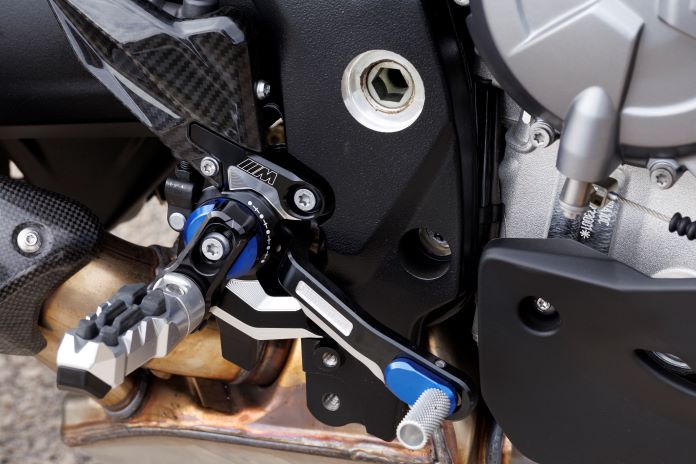
The bike’s twin-beam aluminum frame remains unchanged, but the powerplant bolted to it has undergone serious hot-rodding based on the M 1000 RR’s mill. BMW’s ShiftCam technology accomplishes the magical feat of maintaining optimal power at lower engine speeds while significantly boosting top-end output.
Below 9,000 rpm, the motor is directed by camshaft lobes optimized for operating at lower revs. At higher revs, two electromechanical actuators switch the intake valves over to a hotter cam lobe (more lift and different timing) in just 10 milliseconds. The result is favorable torque in low- and medium-speed ranges along with significant gains in peak power.
Further aiding engine output are a set of variable-length intake ducts stolen from the M 1000 RR and M 1000 R, which switch to shorter ducts above 11,000 rpm. The redline takes a leap from the S 1000 XR’s 12,000 rpm to 14,600 rpm, a seriously high engine speed that is aided by lightweight titanium valves.
Of course, there is no such thing as an inexpensive 200-hp motorcycle. The M 1000 XR has a base price of $24,295, but it doesn’t have to stop there. Preface: Carbon-fiber wheels for a Ferrari 296GTB are a $33,748 option.
Ordering the M Competition package amps up the bike’s racy nature with a slathering of carbon-fiber trim, from a carbon ignition lock cover and cockpit trim to fenders, bodywork, and even a chain guard. The most expensive bits are the M Carbon wheels, which trim unsprung and inertial mass from the place where it makes the most difference on a motorcycle.
If you love carbon fiber (or buy Ferraris), the package’s $5,495 price might seem reasonable, and it also includes special billet footpegs, axle protectors, and a lap-timing GPS trigger. Curb weight gets shaved from 492 lb to 485.
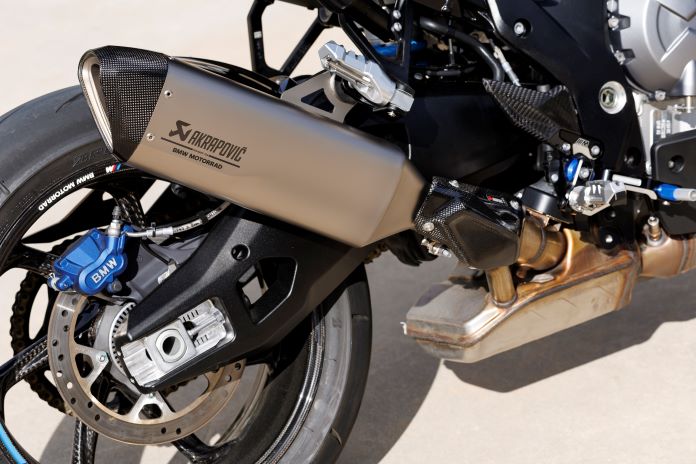
Comfortably Fast | BMW M 1000 XR
In front of our hotel in Spain was a lineup of M 1000 XRs in M Competition livery, a sinister black base peppered with blue and black accents. The overall look is visually arresting, even if it falls short of achieving pure aesthetic beauty.
Throwing over a leg, I was greeted by a relaxed riding position considering this bike’s performance potential. Despite its race-bred DNA, the M 1000 XR doesn’t compromise on rider comfort. The handlebar is within easy reach, and the M-branded seat feels plush. Front and center is a clearly readable 6.5-inch TFT display that can be connected to smartphones. The system’s complex capabilities are navigated by BMW’s innovative Multi-Controller wheel inboard of the left handgrip.
GEAR UP
- Helmet: HJC DS-X1
- Jacket: Alpinestars Hoxton V2
- Pants: Alpinestars Copper V2
- Gloves: Alpinestars GPX V2
- Boots: Alpinestars Soho
Firing up the XR, ears are greeted with a snarling exhaust note emitted by the tidy titanium Akrapovic muffler with a carbon cap. Most of the muffling takes place in a convoluted system of pipework placed under the engine. A quick blip of the throttle immediately sends revs soaring, a portent of fun times to follow.
Clutch pull is modest, and it barely needs to be bothered with thanks to a highly effective quickshifter that swaps cogs seamlessly. Despite the XR’s high-strung potential, it does a fine job of wading through city streets on the way out of town. Power is omnipresent no matter the engine speed, and the bike is easy to manage in tight spaces.
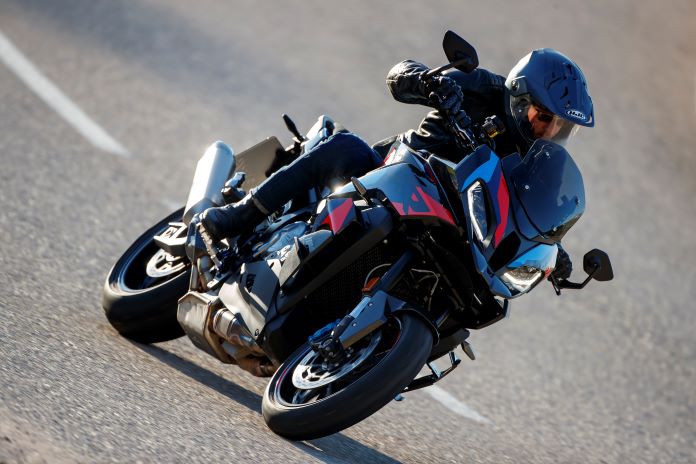
Next up was a highway stint that highlighted the XR’s comfort. The two-position windscreen is adjustable on the fly, and there’s a generous amount of space between the seat and the bars. The seat is fairly tall at 33.5 inches, which allows adequate legroom despite the high-set footpegs that enable dizzying lean angles without touching down. The M Competition foot controls also allow adjustments to fine-tune their fit for different riders.
In this environment, the “Road” ride mode delivers smooth throttle responses and a smooth ride from the semi-active suspension that has 5.4 inches of travel at both ends. Engine vibration is present but isn’t aggravating. Cruise control is standard equipment, and it operates flawlessly and can be set in 1-mph increments.
Ultimate Streetbike Performance | BMW M 1000 XR
After arriving in a rural area, the hilly, twisty roads ahead called for a different ride mode. I toggled to Dynamic, which sharpens the throttle responses and firms up suspension damping. Other modes available are Rain, Race, and three levels of Race Pro. I sampled the Race mode but eventually switched back to Dynamic, which suited me perfectly.
It was finally time to experience the power on tap from the M 1000 XR. Holy crap, this thing is fast! BMW says it can accelerate to 124 mph in just 7.4 seconds – that’s 1.3 seconds quicker than the S 1000 XR, partly due to the M’s shorter gearing. And if you’re brave enough to keep the throttle twisted past that speed, the acceleration forces barely diminish.
Fully up to the task of shedding big speeds are the M-XR’s brakes. I was initially disappointed to not see Brembo’s Stylema calipers, which are often found on premium bikes and are the best clampers I’ve tested. However, the XR’s monoblock Nissin calipers developed with BMW feel just as good as the vaunted Stylemas, with a firm lever and precise feedback. Very impressive!
The Dynamic Damping Control system transforms the suspension from touring-plush to sportbike-firm at the touch of a button. It takes cues from a 6-axis IMU to keep the bike settled regardless of how aggressively it’s ridden.
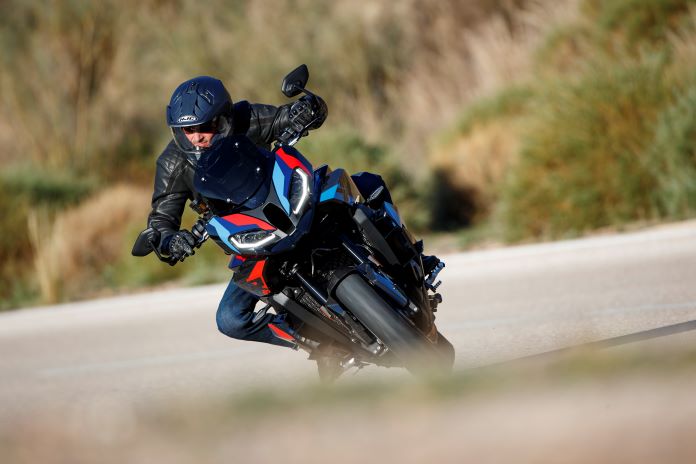
And the M 1000 XR thrives when ridden aggressively. Its relatively high and wide handlebar encourages quick steering transitions, which are certainly aided by the ultra-lightweight carbon wheels. Its agility is exceptional, and once levered over, the sportbike-derived chassis remains steadfast while the suspension’s DDC continually adjusts and adapts to every situation.
Indelible | BMW M 1000 XR
On the way back to the hotel, I reflected on a particular section of our ride. We were untangling a seemingly endless series of twists and turns interjected with occasional straight sections that enabled room to rev out the engine and seamlessly bang a few shifts. I was having so much fun that I was literally grinning and giggling in my helmet.
The M 1000 XR’s extreme performance and unflappable composure made me think I was on one of the best bikes in the world for twisty roads. Its glorious motor provides acceleration that will take your breath away, and you’d think it was terrific even if you never revved it above 9,000 rpm. The M-XR has agility that will shame many sportbikes, and it has race-level braking power backed by cornering ABS.
And when it’s time to leave the canyons, the M-XR transforms into a relatively comfy touring bike. Riders are coddled with decent wind protection, a plush suspension, and amenities like heated grips and cruise control.
Whether unraveling twisty mountain roads or devouring miles on the open highway, the M 1000 XR offers an unrivaled combination of performance, luxury, technological sophistication, and immaculate attention to detail. Now I just gotta remember where I stashed that $30K wad I was setting aside for something special…
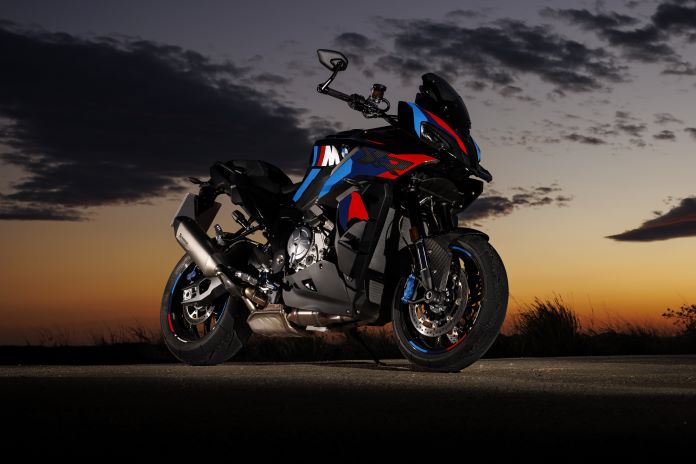
2024 BMW M 1000 XR Specs
- Base Price: $24,295
- Price As Tested: $30,485 (M Competition package)
- Warranty: 2 yrs., unltd. miles
- Website: BMWmotorcycles.com
ENGINE
- Type: Liquid-cooled, transverse inline-Four, DOHC w/ variable valve timing, 4 valves per cyl.
- Displacement: 999cc
- Bore x Stroke: 80.0 x 49.7.0mm
- Horsepower: 201 @ 12,750 rpm (factory claim)
- Torque: 83 lb-ft @ 11,000 rpm (factory claim)
- Compression Ratio: 13.3:1
- Valve Insp. Interval: 18,000 miles
- Fuel Delivery: EFI w/ throttle-by-wire, 48mm throttle bodies
- Transmission: 6-speed, cable-actuated slip/assist wet clutch
- Final Drive: Chain
CHASSIS
- Frame: Twin-beam aluminum, cast aluminum swingarm
- Wheelbase: 60.9 in.
- Rake/Trail: 25.1 degrees/4.6 in.
- Seat Height: 33.5 in.
- Suspension, Front: 45mm inverted fork, semi-active, 5.4 in. travel
- Rear: Single linkage shock,
adj. - Brakes, Front: Dual 320mm discs w/ 4-piston radial calipers & cornering ABS
- Rear: Single 265mm disc w/ 1-piston caliper & cornering ABS
- Wheels, Front: Carbon fiber, 3.5 x 17 (as tested)
- Rear: Carbon fiber, 6.0 x 17 (as tested)
- Tires, Front: 120/70-ZR17
- Rear: 200/55-ZR17
- Wet Weight: 492 lb (as tested, factory claim)
- Fuel Capacity: 5.3 gal.
The post 2024 BMW M 1000 XR Review | First Ride appeared first on Rider Magazine.
]]>The post 2024 BMW F 900 GS Review | Video appeared first on Rider Magazine.
]]>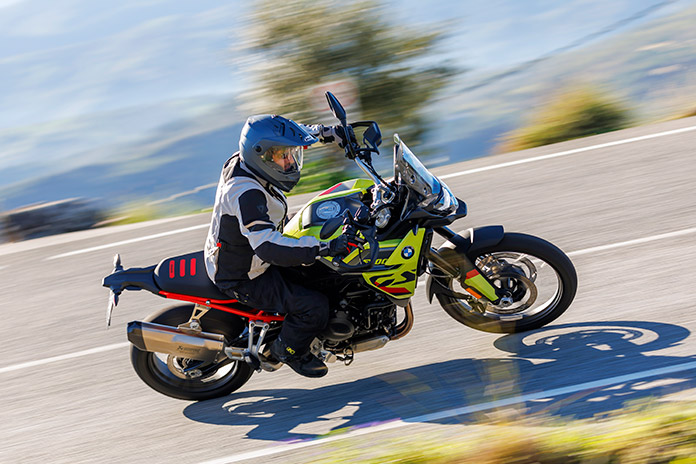
The updated 2024 BMW F 900 GS adventure bike seeks to reinvigorate BMW’s middleweight platform. Upgraded from the F 850 now with a larger 895cc parallel-Twin that delivers 105 hp, a ready-to-ride low weight of 483 lb, a lower and more svelte profile, and upgraded suspension, the 2024 BMW F 900 GS just might be the best parallel-Twin adventure bike ever offered from the German company.
To see how the 2024 BMW F 900 GS performs, we travel to Málaga, Spain, for a full day of on-road and off-road riding. Watch the video below to see the F 900 GS in action, and read our full review here.
2024 BMW F 900 GS Specs
- Base Price: $13,495
- Warranty: 2 yrs., unltd. miles
- Website: BMWmotorcycles.com
ENGINE
- Type: Liquid-cooled, parallel-Twin, DOHC w/ 4 valves per cyl.
- Displacement: 895cc
- Bore x Stroke: 86.0 x 77.0mm
- Horsepower: 105 hp @ 8,500 rpm (factory claim)
- Torque: 68.6 lb-ft @ 6,750 rpm (factory claim)
- Compression Ratio: 13.1:1
- Valve Insp. Interval: 12,000 miles
- Fuel Delivery: EFI w/ throttle-by-wire, 48mm throttle bodies
- Transmission: 6-speed, cable-actuated slip/assist wet clutch
- Final Drive: Chain
CHASSIS
- Frame: Tubular-steel trellis frame & subframe, aluminum swingarm
- Wheelbase: 62.6 in.
- Rake/Trail: 28.0 degrees/4.7 in.
- Seat Height: 34.3 in.
- Suspension, Front: 43mm inverted fork, fully adj., 9.1 in. travel
- Rear: Single linkage shock, w/ adj. spring preload & rebound, 8.5 in. travel
- Brakes, Front: Dual 305mm discs w/ 2-piston axial calipers & cornering ABS
- Rear: Single 265mm disc w/ 1-piston caliper & cornering ABS
- Wheels, Front: Cross-spoke w/ aluminum rims, 2.15 x 21
- Rear: Cross-spoke w/ aluminum rims, 4.25 x 17
- Tires, Front: 90/90-21
- Rear: 150/70-17
- Wet Weight: 483 lb
- Fuel Capacity: 3.8 gal.
Gear Up
- Helmet: HJC DS-X1
- Jacket: Rev’It Neptune 2 GTX
- Pants: Klim Latitude
- Gloves: Rev’It Dirt 3
- Boots: Alpinestars Toucan
The post 2024 BMW F 900 GS Review | Video appeared first on Rider Magazine.
]]>The post 2024 BMW F 900 GS Review | First Ride appeared first on Rider Magazine.
]]>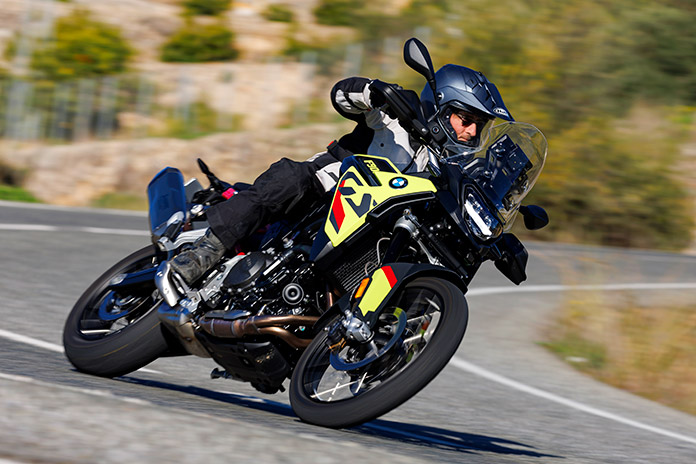
The adventure-bike market is the hottest segment in motorcycling, with new models being introduced every year. The middleweight ADV category has been dominated by Yamaha’s Ténéré 700 and KTM’s various 790/890 Adventure models, but new or updated models from Aprilia (Tuareg 660), Honda (XL750 Transalp), Suzuki (V-Strom 800), and Triumph (Tiger 900) are enticing riders to reevaluate their options.
Meanwhile, BMW has been selling mid-weight ADVs for almost two decades. The F 800 GS was introduced in 2009 but was often overshadowed by its boxer-powered bigger brothers, culminating in the recent glowingly reviewed R 1300 GS.
Related: 2024 BMW R 1300 GS Review | First Ride
For 2024, BMW expects the new F 900 GS to draw a brighter light to its reinvigorated middleweight platform. After testing it on roads and on dirt, we can safely say this is the best parallel-Twin adventure bike ever offered from the German company.
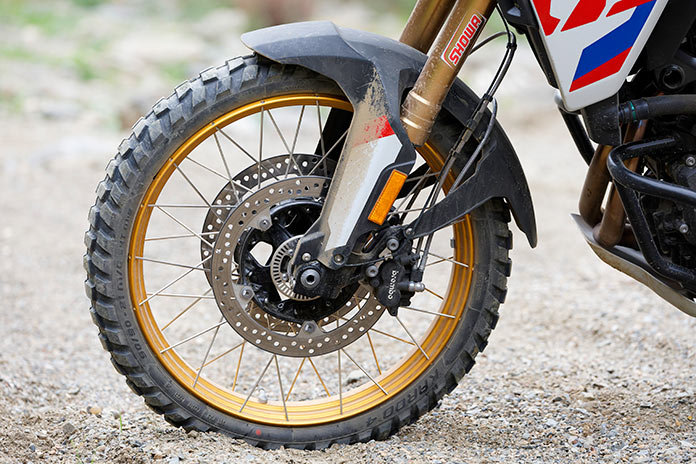
What’s New?
Quite a lot, actually. The F 850’s motor has been punched out to 895cc and now delivers 105 hp, up 10 ponies from the older mill. The former cast pistons have been cast aside for forged pistons that are 2mm larger than before.
Additionally, 31 lb of weight has been shaved off for this new iteration, now scaling in at 483 lb with its 3.8-gallon tank full. The fuel cell swaps steel for plastic to pare down about 10 lb, and a new Akrapovič muffler trims 3.7 lb. A lower tailsection trims another 5 lb, while the trellis steel frame remains unchanged.
The F 900 GS also benefits from a lower and more svelte profile that eliminates much of the bulkiness of its F 850 predecessor. The bike not only looks smaller, its design language looks fresh and contemporary, aided by full LED lighting and rear turnsignals that serve double duty as brake lights.
The F 900 GS is well-equipped in its base form, with a starting price of $13,495. Standard equipment includes a six-axis IMU and two riding modes (Rain and Road), plus ABS Pro and Dynamic Traction Control. A vibrant 6.5-inch TFT display with smartphone connectivity is part of the package, as are hand guards, heated grips, an adjustable aluminum shift lever, and self-canceling turnsignals.
The 900’s suspension has been upgraded, now with a fully adjustable 43mm Showa fork holding a 21-inch front wheel. The rear damper includes adjustable preload and rebound damping to control bumps acting on a slightly lighter aluminum swingarm. Suspension travel is a generous 9.1 inches in front and 8.5 at the rear, resulting in a 34.3-inch seat height. An accessory low seat brings height down to 32.9 inches.
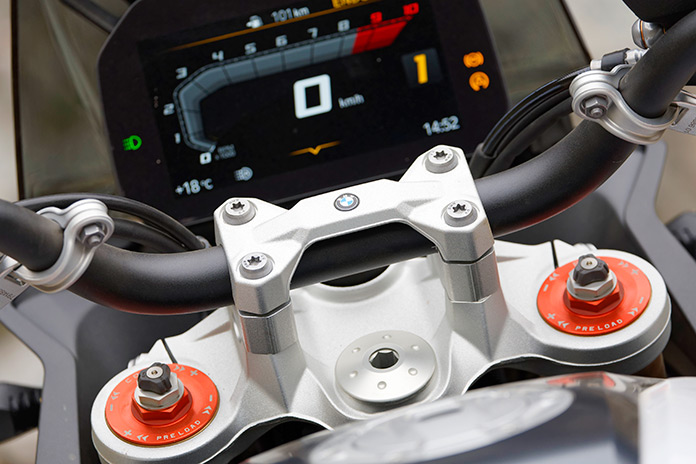
BMW offers a similar but lower-spec (and more street-oriented) F 800 GS for only $10,495, with its 895cc motor downgraded to 87 hp, but it wasn’t available for testing. Also not tested was the Adventure version of the F 900 GS, which includes a 6.1-gallon fuel tank, Dynamic ESA, a luggage rack, and an aluminum bash plate. It has a starting price of $14,890.
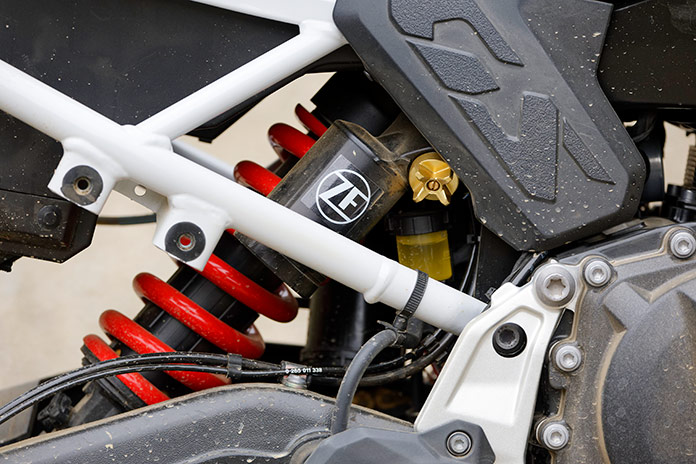
Options Temptations
As is typical for BMW, there are a plethora of options for the F 900 GS. Ride Modes Pro supplies access to Dynamic, Enduro, and Enduro Pro rides modes, as well as Engine Drag Torque Control, which varies the amount of engine braking.
Then there’s the Premium Package that includes Ride Modes Pro, along with keyless ignition, an up/down quickshifter, tire-pressure monitoring, cruise control, and the long-lasting M Endurance Chain. It costs an extra $1,750.
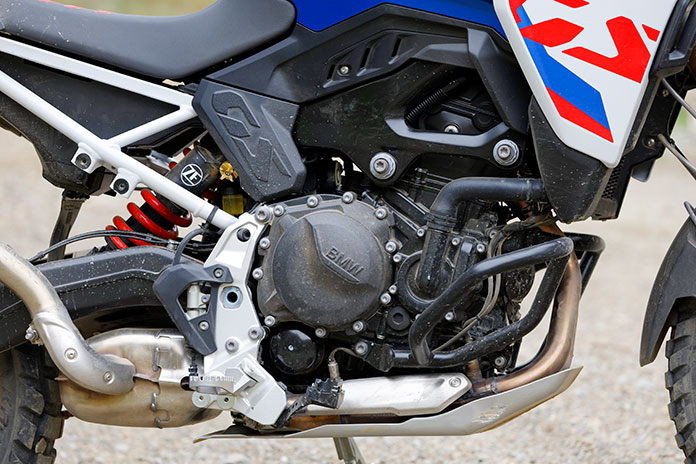
Riders who enjoy traipsing on dirt roads will be interested in the $1,495 Enduro Pro package, which includes Ride Modes Pro, fully adjustable suspension, the M Endurance chain, and a taller handlebar that is more comfortable for stand-up riding.
Other optional equipment includes protective bars, windscreens of various sizes, higher or lower seats, Intelligent Emergency Call, and a full complement of luggage options.
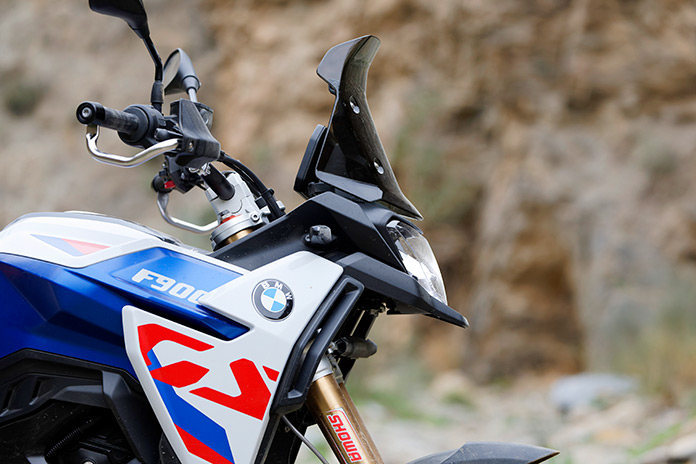
GS en España
BMW invited us to Málaga, Spain, to sample the F 900 GS, and in a coincidental twist, we stayed at the same hotel as during Triumph’s Tiger 900 launch just two months prior! It was illuminating to test these 900cc ADVs in the same area of southeastern Spain.
We first straddled Sao Paulo Yellow versions of the F 900 GS for a morning ride on some of Spain’s countless twisty roads. This “Passion” style colorway adds $275 to the price of the base GS, which has a black colorway. Our bikes had other options that raised their MSRP to $16,215.
The F 900’s parallel-Twin motor emits a rumbly note through its new Akrapovič muffler. Its crankshaft journals are offset by 90 degrees to create a 270/450-degree firing interval that sounds a lot like a 90-degree V-Twin. A pair of counterbalancers (one in front of and one behind the crankshaft) minimize objectionable vibrations.
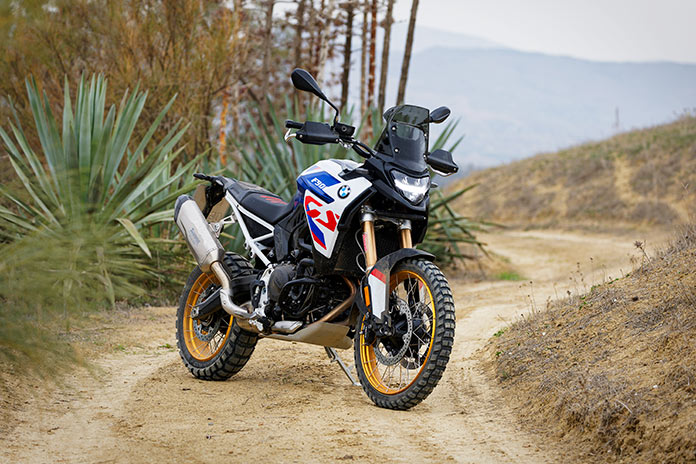
Responses from this invigorated mill are much punchier than before. It pulls cleanly from as low as 2,000 rpm and builds to a meaty midrange that thrusts the Beemer forward with satisfying alacrity, aided by lower final-drive gearing. Torque swells in the 6,000-rpm range to its 68.6 lb-ft peak at 6,750 rpm then yanks harder on the way to its 105-hp zenith at 8,500 rpm.
For comparison, Triumph’s upgraded 888cc three-cylinder motor in the Tiger 900 cranks out 106.5 hp, while the output of KTM’s respected 890 parallel-Twin produces 103.6 ponies. It’s remarkable how closely the engines of these middleweight ADVs match up.

My 30-inch inseam was a little intimidated by the relatively tall 34.3-inch seat height, but it wasn’t a problem after my weight was aboard and the suspension compressed. The bike proved to be adept at navigating city streets on the way to mountain roads, with a light clutch pull and the assistance of the quickshifter fitted to our bikes.
The cockpit of the GS is pleasing to the eye, with an attractive 6.5-inch color TFT display front and center. It includes smartphone connectivity and can easily be navigated with BMW’s innovative Multicontroller wheel on the left grip. A 12-volt socket and a USB port ensure your devices will be charged while out on the road.
Riding on a highway section revealed a foible in the GS. Unlike the Tiger’s, the BMW’s windscreen isn’t adjustable. The accessory screen, which is 2 inches taller than stock, fitted to our test bikes induced buffeting on my helmet at higher speeds, and the lack of adjustability forced me to endure it. Any bike intended for travel should have a simple system for on-the-fly windscreen adjustments.
The GS proved to be remarkably adroit on the twisty sections of our ride. Turn-in response isn’t quite as brisk as on the Tiger due to the GS’s more relaxed steering geometry, with a 28-degree rake and 4.7 inches of trail, but the GS’s weight loss and its wide handlebar helps it carve corners adeptly. The 21-inch front tire (Bridgestone Battlax Adventure A41) slightly diminishes sporty front-end feedback, as is always the case, but not enough to inhibit acute lean angles. For what it’s worth, I was able to drag footpegs on the Tiger Rally Pro, but I didn’t on the BMW.
The long-travel suspension of the GS proved to be plush over various road surfaces, but several riders noted the rebound damping of the shock felt too loose, with the rear bouncing up excessively after hitting bumps. At a coffee stop, we all dialled in additional rebound damping on the shock, and the revised settings offered much better control. The shock’s spring preload is adjustable, but its compression-damping circuit is not.
The fully adjustable inverted fork performed well, but less impressive are the GS’s brakes. Up front are Brembo calipers, but they’re low-spec 2-piston units rather than 4-piston clampers that are typically employed on bikes in this price range. They offer plenty enough power to adequately slow the bike, sure, but they’re not up to the high standards of the class. Cornering ABS is a welcome safety feature that is included as standard equipment.
Gear Up
- Helmet: HJC DS-X1
- Jacket: Rev’It Neptune 2 GTX
- Pants: Klim Latitude
- Gloves: Rev’It Dirt 3
- Boots: Alpinestars Toucan
There were several opportunities on our ride to twist the throttle wide open and stretch speed limits. The newfound punchiness of the motor again impressed the seat of my pants, pulling hard enough to make me feel that a 1,200-plus-cc engine might be overkill for an ADV. Clutchless upshifts were clicked off smoothly, but snicking into lower gears without using the clutch was harsher than with the Tiger’s faultless transmission.
We were having so much fun unwinding Spain’s sinuous backroads on the GS that we didn’t want to bother stopping for lunch.
Dirty Work
After some delicious tapas, we climbed aboard bikes in the GS Trophy colorway with BMW’s red and blue colors atop a white base coat, sure to be the likely choice for Beemerphiles. These bikes were fitted with knobbier Metzeler Karoo 4 tires better suited for the off-roading adventures in front of us. BMW’s cross-spoke wheels allow tubeless tires.
Like a well-engineered ADV should, the F 900 GS seems to shed weight when ridden off-road. Simply point it in the right direction and keep the throttle open, and it tractors up nearly any obstacle. While most of our off-roading was on non-technical terrain, we came across a few technical sections with rocks and hills that gave the GS a good test. Its suspension performed without complaint from the bike or its rider, and its punched-out motor again proved its worthiness in ADV situations, able to be lugged low in its powerband where optimum traction is delivered.
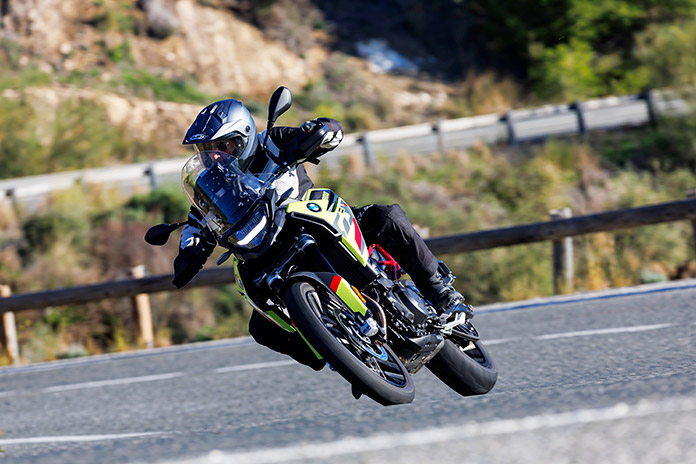
I spent the entire afternoon with the bike in its Enduro Pro mode, which disables ABS at the rear tire and loosens the limits of traction control. Eventually, I switched off traction control completely, as I preferred my right hand to be fully in charge of managing traction.
The brakes that felt underwhelming on the street were nearly perfect in the dirt. They weren’t grabby or overly sensitive like some high-powered braking systems, shedding speed in precise and easy to control amounts. However, I felt the front ABS kick in on a rocky, technical downhill section, an unnerving situation. A ride mode with the name “Pro” in it should have looser parameters for ABS intervention.
On the way back into town, I was pleased that the standard-height windscreen eliminated the buffeting condition I felt at higher speeds with the taller screen. The narrow seat, however, was less pleasing, and I’d consider sourcing a different saddle if I was piling on hundreds of miles. On the plus side, a generous amount of steering lock makes the GS easy to maneuver in tight spaces, whether it’s dodging trees in a forest or Teslas in a crowded parking lot.
Best GS Yet?
Well, that would depend on what you want from a GS. The new R 1300 GS is magnificent and has a broader range of capabilities along with a more powerful engine. But after a short spin on a 1300 during a transit stage of our off-road ride, I preferred the 900’s relative agility and the way its rear tire grabbed for traction relative to the 1300’s shaft-drive arrangement.

The F 900 GS faces stiff competition in the marketplace. The Tiger 900 Rally Pro is in some respects more appealing than the Beemer, with its engaging 3-cylinder engine, Brembo Stylema brakes, and adjustable windscreen. Combined with a larger fuel tank and a comfier stock seat, the Tiger is a worthy adversary.
But the BMW F 900 GS is appealing in its own right, flying the BMW flag high for aficionados of the brand. The Beemer is built in Germany, the land of technocrats and precision engineering, while the Tiger is produced in Thailand, for whatever that’s worth to ya.
For my money, on a per-dollar value, I believe the BMW F 900 GS is the best GS yet.
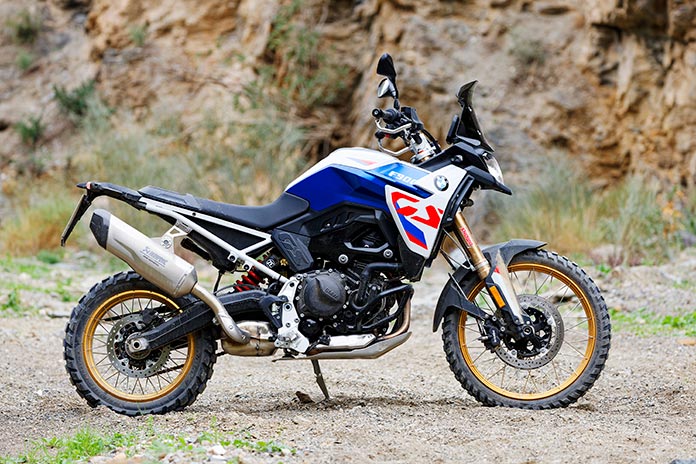
2024 BMW F 900 GS Specs
- Base Price: $13,495
- Warranty: 2 yrs., unltd. miles
- Website: BMWmotorcycles.com
ENGINE
- Type: Liquid-cooled, parallel-Twin, DOHC w/ 4 valves per cyl.
- Displacement: 895cc
- Bore x Stroke: 86.0 x 77.0mm
- Horsepower: 105 hp @ 8,500 rpm (factory claim)
- Torque: 68.6 lb-ft @ 6,750 rpm (factory claim)
- Compression Ratio: 13.1:1
- Valve Insp. Interval: 12,000 miles
- Fuel Delivery: EFI w/ throttle-by-wire, 48mm throttle bodies
- Transmission: 6-speed, cable-actuated slip/assist wet clutch
- Final Drive: Chain
CHASSIS
- Frame: Tubular-steel trellis frame & subframe, aluminum swingarm
- Wheelbase: 62.6 in.
- Rake/Trail: 28.0 degrees/4.7 in.
- Seat Height: 34.3 in.
- Suspension, Front: 43mm inverted fork, fully adj., 9.1 in. travel
- Rear: Single linkage shock, w/ adj. spring preload & rebound, 8.5 in. travel
- Brakes, Front: Dual 305mm discs w/ 2-piston axial calipers & cornering ABS
- Rear: Single 265mm disc w/ 1-piston caliper & cornering ABS
- Wheels, Front: Cross-spoke w/ aluminum rims, 2.15 x 21
- Rear: Cross-spoke w/ aluminum rims, 4.25 x 17
- Tires, Front: 90/90-21
- Rear: 150/70-17
- Wet Weight: 483 lb
- Fuel Capacity: 3.8 gal.
The post 2024 BMW F 900 GS Review | First Ride appeared first on Rider Magazine.
]]>The post Paul Yaffe Creates Custom BMW R 18 One Eight “C” appeared first on Rider Magazine.
]]>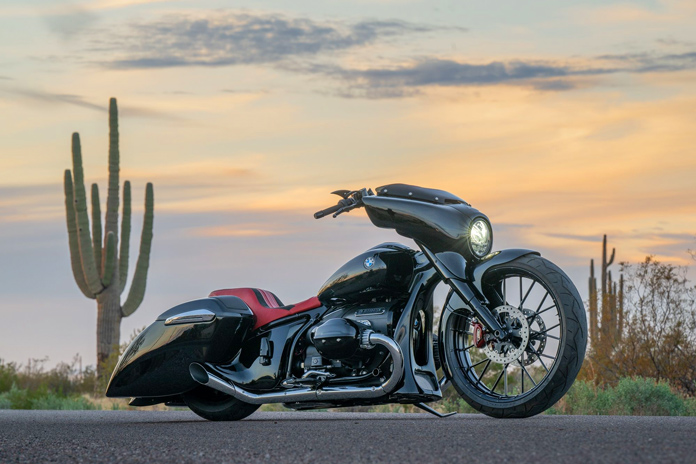
Paul Yaffe of Bagger Nation has recently revealed his latest creation: the BMW R 18 One Eight “C” built on a BMW R 18 Transcontinental. This custom incorporates hot-rod appeal while remaining as authentically BMW as possible and joins Yaffe’s extensive list of customized bikes.
Yaffe is well-known to the custom motorcycle world. His bikes show up across the globe at various bike shows, rallies, and events, and he’s been awarded recognitions such as three “World’s Most Beautiful Motorcycle” awards from the Oakland Roadster Show and two “Builder of Year” and three “Trendsetter of the Year” awards from Easyriders Magazine. He was also inducted into the Sturgis Hall of Fame in 2015.
To get accustomed with the BMW R 18 Transcontinental, Yaffe rode more than 6,000 miles on one before getting started with the project. The BMW R 18 Transcontinental was introduced for 2022 as a luxury touring version of the company’s R 18 cruiser platform. It features the same 1,802cc “Big Boxer” opposed Twin as other R 18 iterations. The Transcontinental comes with a handlebar-mounted fairing, a passenger seat, locking hard saddlebags, and a top trunk with integrated passenger backrest – everything needed for racking up miles on cross-country trips.
Related: 2022 BMW R 18 Transcontinental | Road Test Review
Yaffe’s goal with this custom was to create a big-wheel bagger that retained as many original BMW parts as possible. The eye-catching 26 x 5.5-inch front wheel was commissioned and cut from solid aluminum, and the 180mm front tire is handmade. To accommodate the large front wheel, the frame was stretched and raked.
The R 18’s batwing-style fairing was cut into several pieces and restructured, and the steel front fender was made from scratch. The bike also features a chin spoiler that conceals the radiator and closes the gap between the fairing and the fuel tank. Also included is a set of Yaffe Monkey Bars.
In keeping with Yaffe’s goal to keep as many BMW components on the bike as possible, his team retained the saddlebag lids, latches, and speakers but included a new set of “skins” that create a stretched look. The team also extended the original rear fender by crafting a second R 18 fender.
Yaffe kept the original R 18 taillights and fitted them into handmade filler panels. He also included a spot for a license plate in the fender and stretched the side covers to cover more area and flow toward the saddlebags.
The R 18 One Eight “C” features air suspension with a Yaffe-designed air tank and distribution system. A frame under the saddlebags accommodates components of the air suspension. The team’s goal with the side pipes was to “preserve the distinct BMW feel” of the build. They kept the classic Boxer head pipes, removed the catalytic converters from the head pipes, and installed a perforated high-flow baffle system. They also included a three-step muffler system and a wide-open megaphone for a classic hot-rod sound.
The focus on the bike’s cosmetics was centered on elegance and simplicity. “We went to work perfecting all the fabricated body panels and smoothing everything to a glass-like finish,” said the Bagger Nation team. Painter Hector Martinez applied the gloss black paint for a timeless look, and Guys Upholstery created the oxblood red saddle and the dash console. Martinez matched the front calipers’ color to the saddle.
The BMW R 18 One Eight “C” will debut at the Motor Bike Expo in Verona, Italy, the weekend of January 19-21, 2024.
The post Paul Yaffe Creates Custom BMW R 18 One Eight “C” appeared first on Rider Magazine.
]]>The post 2024 BMW R 12 nineT and R 12 Review | First Look appeared first on Rider Magazine.
]]>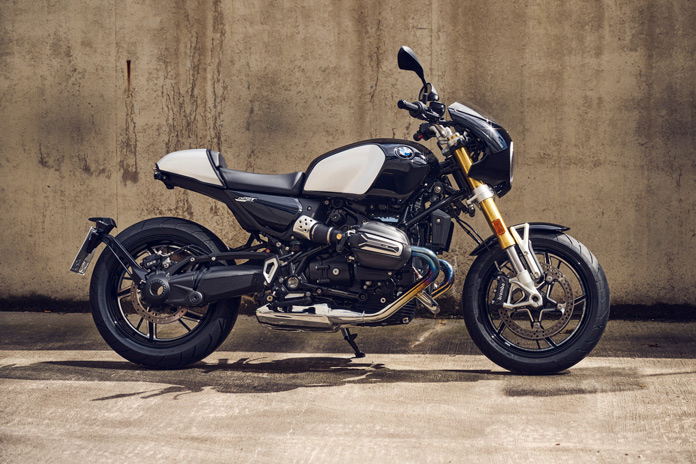
BMW has released details on two models that will replace the BMW R nineT: the BMW R 12 nineT and the new cruiser-styled R 12. The “12” in the names of these two models comes from their 1,170cc boxer Twin, and both bikes feature a new frame, new technology, and other updates.
The R 12 nineT “classic roadster” carries on in the tradition of the R nineT with suitability for urban riding and a dynamic ride, while the R 12 features some different components and ergonomics designed for comfortable cruising.
The two new models are powered by an air/oil-cooled 1,170cc flat-opposed Twin with DOHC, the same engine found in the R nineT. In the R 12 nineT, BMW claims 109 hp at 7,000 rpm and 85 lb-ft of torque at 6,500 rpm. For the R 12, it claims 95 hp at 6,5000 rpm and 81 lb-ft at 6,000 rpm. The engine redliens at 8,500 rpm.
Related: 2023 BMW R nineT 100 Years Edition Review | Road Test
Different from the R nineT, the 2024 R 12 models get a new airbox that is now integrated under the seat. Also new is the twin pipe exhaust system. The two rear mufflers on the left-hand side feature a reverse-cone cap design. On the R 12 nineT, the front muffler is chrome-plated, and the rear muffler is electro-polished. On the R 12, the front muffler is electro-polished while the rear muffler has a brushed finish.
Another big update from the previous R nineT is the new one-piece trellis steel main frame to replace the previous two-piece frame. BMW claims that this new frame weighs less and gives the R 12 models a cleaner look.
Both models feature cast light-alloy wheels, with 17-inch front and rear wheels on the R 12 nineT and 19-inch front with 16-inch rear wheels on the R 12. Both bikes also get dual 310mm brake discs up front with radially mounted 4-piston monoblock calipers and a single 265mm disc in the rear with a 2-piston caliper, and BMW Motorrad ABS Pro comes standard.
The R 12 nineT has a wheelbase of 59.5 inches, a rake of 27.7 degrees, a trail of 4.4 inches, and a seat height of 31.3 inches. The R 12 features a wheelbase of 59.8 inches, a rake of 29.3 degrees, a trail of 5.2 inches, and a lower seat height of 29.7 inches.
Related: 2024 BMW R 1300 GS Review | First Ride
Both new models also feature a new 45mm inverted telescopic fork, which is fully adjustable on the R 12 nineT. Rear suspension is provided by a Paralever swingarm with a linked shock with adjustable spring preload and rebound damping. Suspension travel front and rear is 4.7 inches on the R 12 nineT and 3.5 inches on the R 12.
These two new models also come equipped with plenty of tech and electronic rider aids. The R 12 nineT has three ride modes (Rain, Road, and Dynamic), and the R 12 gets two ride modes (Roll and Rock). These ride modes adjust throttle response and the equipped Dynamic Traction Control and Engine Drag Torque Control. Engine Drag Control works to prevent rear wheel slip when abruptly releasing the throttle or downshifting.
These models also come standard with a Keyless Ride function, with the key now only being needed for the steering lock and fuel cap. BMW’s Intelligent Emergency Call, which calls for help in case of an accident, is also included as standard on both models.
Related: BMW Announces New Intelligent Emergency Call Feature, 2024 Motorcycle Lineup
Adding to the list of technology available on the BMW R 12 models is new instrumentation. The R 12 nineT is equipped with two round analog gauges (speedometer and tachometer), a USB-C charging port, and a 12V socket. The R 12 gets only the speedometer. Control lights and a digital display are integrated into the speedometer on both models. The display functions as a scrollable menu on the R 12 nineT and displays gear and ride mode on the R 12. Riders can also choose to purchase the option Digital Display, which replaces the round analog units with a 3.5-inch TFT display. Both models also come with full LED lighting.
In addition to many standard electronic elements, the BMW R 12 nineT and R 12 offer several optional rider aids. The optional Shift Assistant Pro allows for clutchless shifting, and Hill Start Assist Pro holds the brakes when on a hill and releases the brakes when starting from a stop. Another option is Connected Ride Control, which allows for Bluetooth connectivity to a smartphone. From the BMW Motorrad Connected app, the rider can find vehicle data, riding dynamics data, weather info for the current location, and map navigation. The MotoMount is available as an option to allow for mounting a smartphone to the handlebar.
The BMW R 12 models will each come in three color options. The standard color for both models is Blackstorm Metallic. The R 12 nineT will also come in an optional San Remo Green Metallic, while the R 12 will be available in an optional Aventurine Red Metallic. Both models will be available in Option 719 colors. The R 12 nineT will start at $16,295, and $12,345 for the R 12. BMW expects these models to arrive in dealerships during the first quarter of 2024.
Check out more new motorcycles in Rider’s 2024 Motorcycle Buyers Guide.
The post 2024 BMW R 12 nineT and R 12 Review | First Look appeared first on Rider Magazine.
]]>The post 2024 BMW R 1300 GS Review | Video appeared first on Rider Magazine.
]]>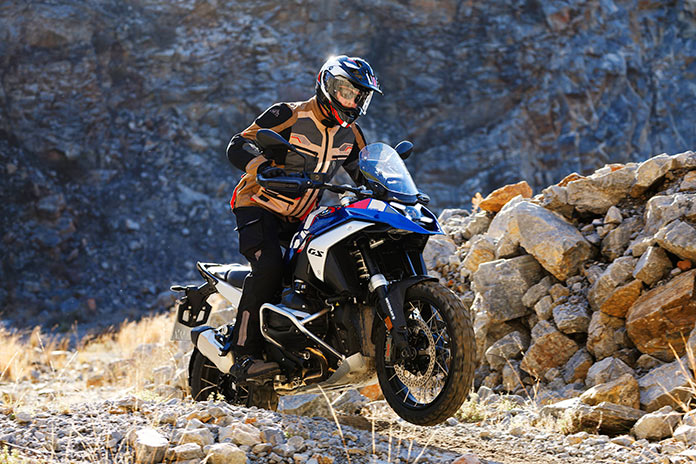
BMW Motorrad pulled out all the stops in 2023 to celebrate the 100th anniversary of its first production motorcycle (the R 32). It launched 100 Years Editions of the R 18 cruiser and R nineT roadster, it hosted its first-ever BMW Motorrad Days Americas at the Barber Vintage Festival, and on Sept. 28, exactly 100 years after the R 32 was unveiled at the Berlin Motor Show, it introduced the 2024 BMW R 1300 GS, the latest version of its bestselling model.
Related: 2023 BMW R nineT 100 Years Edition Review | Road Test
With a pedigree that goes back 43 years to the original R 80 G/S, which introduced the Gelände/Straße (“off-road/road”) concept and started the adventure bike revolution, the R 1300 GS is new from the ground up. Only the butterfly valves and a few bolts and connectors carry over from the R 1250 GS.
You can read our full review here.
2024 BMW R 1300 GS Specs
- Base Price: $18,895
- Warranty: 3 yrs., 36,000 miles
- Website: BMWMotorcycles.com
ENGINE
- Type: Air/oil-cooled, longitudinal opposed flat Twin, DOHC w/ 4 valves per cyl.
- Displacement: 1,300cc
- Bore x Stroke: 106.5 x 73.0mm
- Compression Ratio: 13.3:1
- Valve Insp. Interval: 6,000 miles
- Fuel Delivery: Fully sequential EFI, 52mm throttle bodies x 2
- Lubrication System: Wet sump, 4.2 qt. cap.
- Transmission: 6-speed, hydraulically actuated slip/assist wet clutch
- Final Drive: Shaft
CHASSIS
- Frame: Two-section sheet metal main frame w/ engine as stressed member, cast-aluminum subframe, single-sided cast-aluminum swingarm
- Wheelbase: 59.8 in.
- Rake/Trail: 26.2 degrees/4.4 in.
- Seat Height: 33.5 in.
- Suspension, Front: EVO Telelever w/ single shock, fully adj., 7.5 in. travel
- Rear: EVO Paralever w/ single shock, fully adj., 7.9 in. travel
- Brakes, Front: Dual 310mm floating discs w/ radial-mount opposed 4-piston calipers & ABS
- Rear: Single 285mm disc w/ floating 2-piston caliper & ABS
- Wheels, Front: Cast, 3.00 x 19 in.
- Rear: Cast, 4.50 x 17 in.
- Tires, Front: Tubeless, 120/70-ZR19
- Rear: Tubeless, 170/60-ZR17
- Wet Weight: 523 lb (factory claim)
- Load Capacity: 502 lb
- GVWR: 1,025 lb
PERFORMANCE
- Horsepower: 145 @ 7,750 rpm (factory claim)
- Torque: 105 lb-ft @ 6,500 rpm (factory claim)
- Fuel Capacity: 4.5 gal.
The post 2024 BMW R 1300 GS Review | Video appeared first on Rider Magazine.
]]>The post 2024 BMW R 1300 GS Review | First Ride appeared first on Rider Magazine.
]]>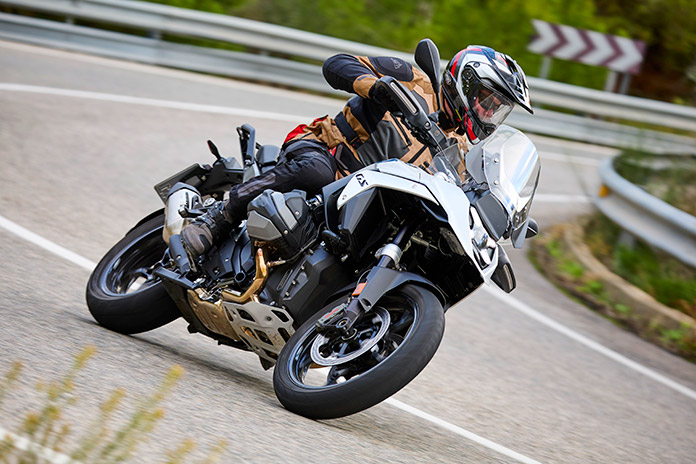
On Sept. 28, 2023, BMW Motorrad celebrated the 100th anniversary of its first production motorcycle (the R 32) by unveiling the latest version of its bestselling motorcycle, the 2024 BMW R 1300 GS. With a pedigree that goes back 43 years to the original R 80 G/S, which introduced the Gelände/Straße (“off-road/road”) concept and started the adventure bike revolution, the R 1300 GS is new from the ground up. Only the butterfly valves and a few bolts and connectors carry over from the R 1250 GS.
Development of the R 1300 GS started six years ago – two years before the R 1250 GS was introduced. Having squeezed as much as they could out of the existing platform, which started with the R 1200 GS introduced in 2004, BMW’s designers and engineers knew that taking the R-series GS into the future and maintaining its position in the market required a clean-sheet design.
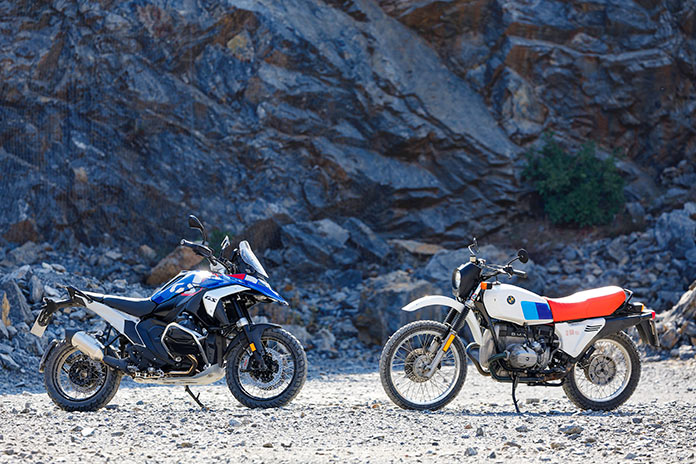
Related: 2021 BMW R 1250 GS 40 Years Edition | Road Test Review
BMW R 1300 GS: New from Stem to Stern
The design objectives were to make the R 1300 GS lighter, more compact, more powerful, and more capable than its predecessor. The only thing that couldn’t change was the engine configuration; the new GS had to have a flat-Twin boxer, but nearly everything else about the engine is new. Displacement increased from 1,254cc to 1,300cc, achieved by a larger 106.5mm bore (up from 102.5) and a new crankshaft that shortened the stroke to 73mm (from 76). Peak horsepower increased from 136 to 145, peak torque increased from 105 to 110 lb-ft, and there’s more torque throughout the rev range, with more than 96 lb-ft available from 3,600 to 7,800 rpm (redline is 9,000 rpm).
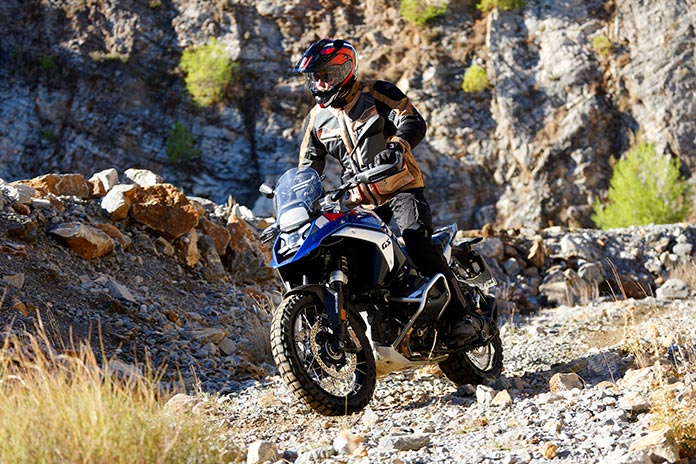
GEAR UP
- Helmet: Shoei Hornet X2
- Jacket: Tourmaster Ridgecrest
- Gloves: Tourmaster Overlander
- Pants: Tourmaster Ridgecrest
- Boots: Sidi Adventure 2 Gore-Tex
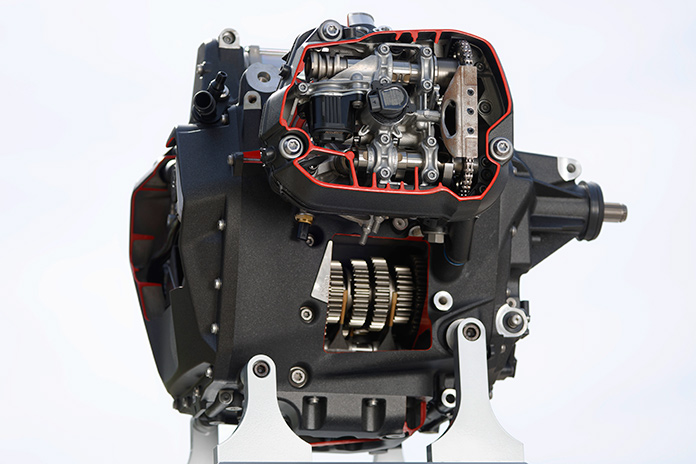
Like its predecessor, the new boxer has air/liquid-cooled cylinders, ShiftCam variable valve timing, and DOHC with four valves per cylinder. The cams are driven by a new timing chain arrangement, with the right cylinder’s timing chain in front of the cylinder and the left cylinder’s timing chain behind the cylinder. Helping achieve the increased power and torque result are revised cam timing, larger valves (44mm intake, up from 40; 35.6mm exhaust, up from 34), and a higher compression ratio (13.3:1, up from 12.5:1).
The R 1300 GS has four standard ride modes: Road, Rain, Eco, and Enduro. Optional Ride Modes Pro adds three additional modes – Dynamic, Dynamic Pro, and Enduro Pro – and the two Pro modes can be customized. Each mode has presets for various standard electronic functions, including throttle response, Dynamic Traction Control, cornering ABS Pro, Dynamic Brake Control, MSR (engine braking torque), and Hill Start Control Pro, as well as optional Dynamic Suspension Adjustment.
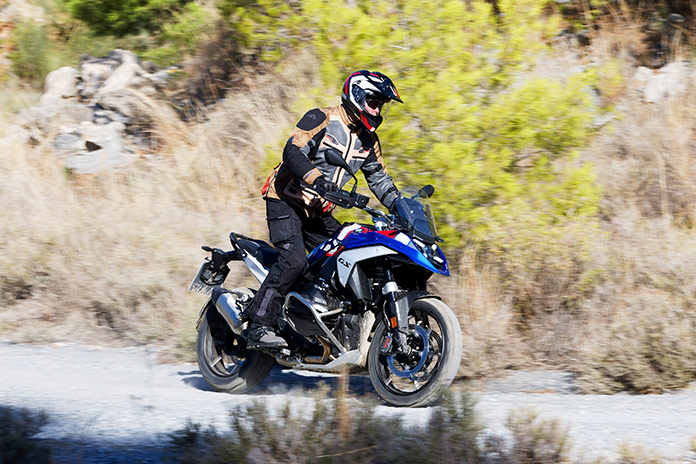
Claimed wet weight for the R 1300 GS is 523 lb – 26 lb less than the R 1250 GS. Despite the increase in displacement and power, the engine is nearly 9 lb lighter, while the entire powertrain is more than 14 lb lighter. A new lithium battery shed another 5.5 lb, and reducing fuel capacity from 5.3 to 5.0 gallons saved 1.8 lb. The gearbox was moved under the engine, which was made possible by reducing the number of transmission shafts from three to two. The more compact engine allowed BMW to package everything more tightly and better centralize mass. Even though the engine was moved up to accommodate the gearbox, the bike’s overall center of gravity and weight distribution have not changed.
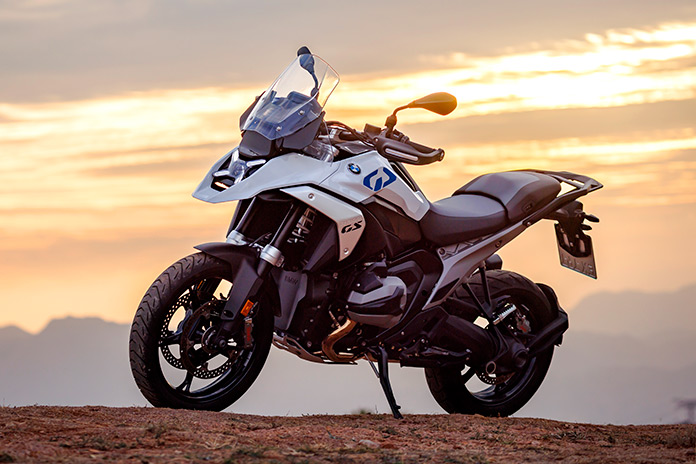
As part of the GS’s tighter packaging, the previous tubular-steel space frame has been replaced with a precisely formed and laser-welded sheet-metal main frame that uses the engine as a structural component. The tubular-steel subframe has been replaced with a cast-aluminum subframe that is said to be lighter, stiffer, narrower, and more tightly bonded to the main frame. Since the weight of the rider, passenger, and luggage is carried by the subframe, the new design improves stability and riding dynamics.

For three decades, the R-series GS platform has used BMW’s proprietary Telelever front suspension system, which separates suspension forces from steering inputs. The Telelever uses a swingarm that connects the frame to the lower triple clamp through a ball joint. The fork’s stanchions slide within the tubes like on a telescopic fork, but the fork doesn’t control damping; that’s handled by a single central shock between the Telelever’s swingarm and the frame. The tops of the fork stanchions are connected to the handlebar plate via ball joints. As the suspension moves through its stroke, the swingarm moves through an arc, and the upper and lower ball joints compensate for the Telelever’s torsional movement.
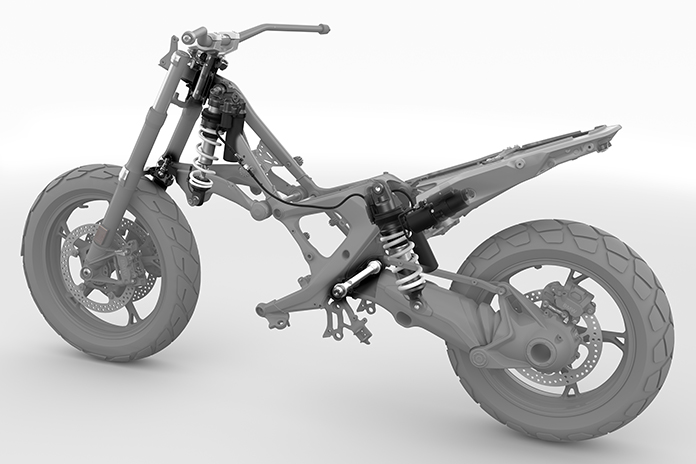
The R 1300 GS is equipped with the next-gen EVO Telelever system, which eliminates the ball joints atop the fork tubes and instead uses a metal flex plate between the handlebar plate and the upper triple clamp. The flex plate accommodates the Telelever’s torsional movement but does so with less friction and more stiffness than the ball joints. To further reduce friction, a radial spherical plain bearing connects the upper triple clamp to the steering stem, which is guided within the frame via a cylindrical roller bearing at the top and a deep-groove ball bearing at the bottom. There’s also an extra roller bearing for the ball joint that connects the Telelever swingarm to the lower fork bridge. Increasing the front wheel axle’s diameter by 0.2 inch to 1.0 inch contributes additional stiffness to the front end, and the new axle is 1.7 oz. lighter.
There’s also a new EVO Paralever rear suspension. Moving the gearbox under the engine allowed the single-sided swingarm to be made longer for better traction (wheelbase has increased by only 0.2 inch). The EVO system has a stiffer connection between the rear shock and the frame, and the swingarm bearing is arranged off-axis to the rotation of the cardan shaft joint. The driveshaft has larger universal joints, and a longer rear-axle wheel stub makes it easier to remove and mount the rear wheel.
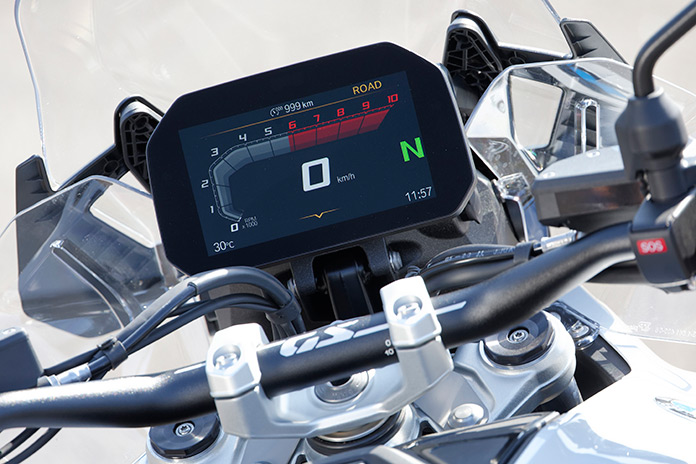
The optional Dynamic Suspension Adjustment not only electronically adjusts damping depending on suspension mode and conditions, it also automatically adjusts preload to compensate for varying loads. Within the front and rear shocks’ remote reservoirs are secondary springs that allows DSA to use different spring rates for on-road and off-road ride modes.
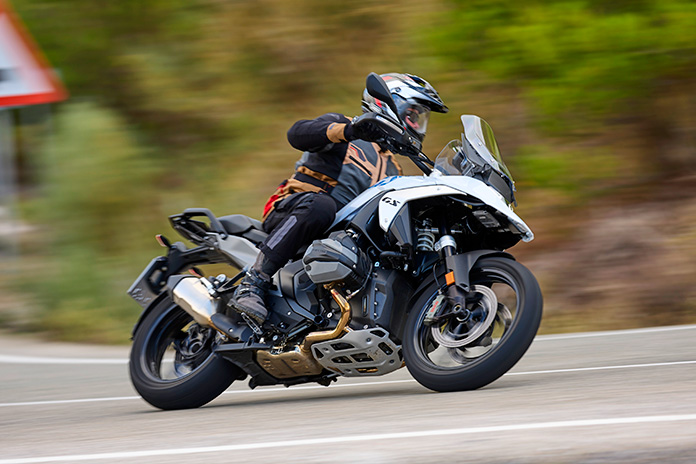
Two new suspension options are also available. One is adaptive vehicle height control, which lowers seat height from 33.5 to 32.3 inches and can be set to automatically adjust seat height or to stay at the low or high heights. In the other direction, sports suspension, which is designed for aggressive off-road riding, adds 0.8 inch of front/rear travel and firmer damping.
With its sharper beak, more integrated bodywork, and new frame and subframe, the styling of the R 1300 GS is a radical departure from the R 1250 GS, so much so that initial reactions were mixed when we posted an announcement online. While styling is highly subjective, the new GS is best appreciated in person; photos don’t do it justice, and I count myself as a fan of the new look.
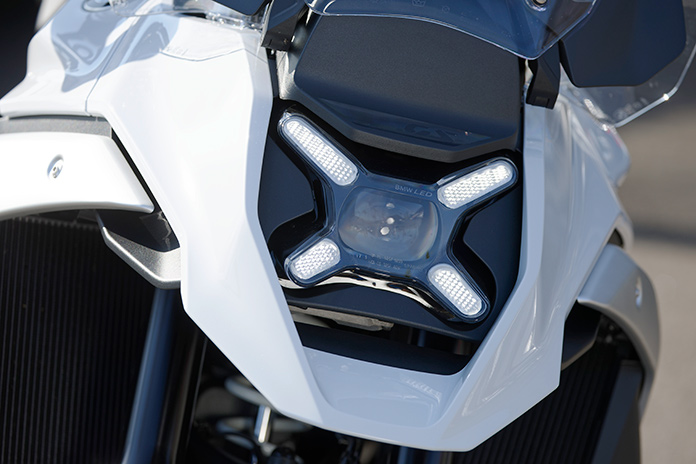
The R 1300 GS has a more aggressive and aerodynamic profile, with a flatter tank and a slimmer tailsection. Perhaps most controversial of all is the centralized X-shaped headlight that replaces the asymmetrical headlight that’s been a signature GS styling element for many years. The new design was guided in part by new homologation requirements but also by a desire to create a distinctive new look that will be instantly recognizable.
Riding the BMW R 1300 GS
We spent two days riding the R 1300 GS on- and off-road for nearly 300 miles at the global press launch in southern Spain. Over the past 15 years, with thousands of miles ridden on intros, road tests, and nearly a dozen overseas tours, I’ve logged more miles on BMW R 1200/1250 GS models than any other motorcycle. Hands down, the R 1300 GS is the best GS yet. The traits that the boxer-powered GS are known for – engine character, balance, comfort, and versatility – are better than ever. It looks and feels much slimmer than before, and the increased power and torque are impressive.

Thanks to the stiffer chassis and new EVO Telelever/Paralever suspension, the R 1300 GS feels more stable both on-road and off-road, yet its steering is lighter and sharper. Whereas the previous Telelever setup offered responsive handling but muted feedback, the EVO Telelever sends clearer signals to the rider through the handlebar.
During our off-road test, we rode the Trophy variant of the R 1300 GS with cross-spoke wheels and Metzeler Karoo 4 tires. Balanced and predictable low-speed handling has long been a hallmark of boxer-powered GS models, and the R 1300 GS chugged along happily on singletrack gravel trails and wooded paths. At higher speeds up and down an unpaved road covered in fist-sized rocks, the GS improved upon what it’s known for: handling better off-road than a bike of its size should. Standing on the pegs felt very natural thanks to the slimmer tank and midsection and 1.2-inch-taller handlebar.
Our off-road test was no more than 10 miles total, primarily just a photo opportunity at an enduro park in a former rock quarry. We made fast runs on gravel, slow runs on rocky singletrack, and chugged up a rocky road to a vista high above the Mediterranean coast – enough for a taste test but certainly well short of a full meal. We’ll have to wait until we get a test bike to do a more thorough assessment of the bike’s off-road prowess.
On-road is where we logged most of our miles, everything from freeways to traffic-choked city roads with slippery roundabouts to a 10-course meal of backroads that snaked from the coast up into the mountains and back down again. The GS was responsive and easy to handle in all conditions, but it really came alive on tight, twisty roads in the Sierra de las Nieves range. I was able to push harder with more confidence, especially with the firmer suspension damping in Dynamic Pro mode.
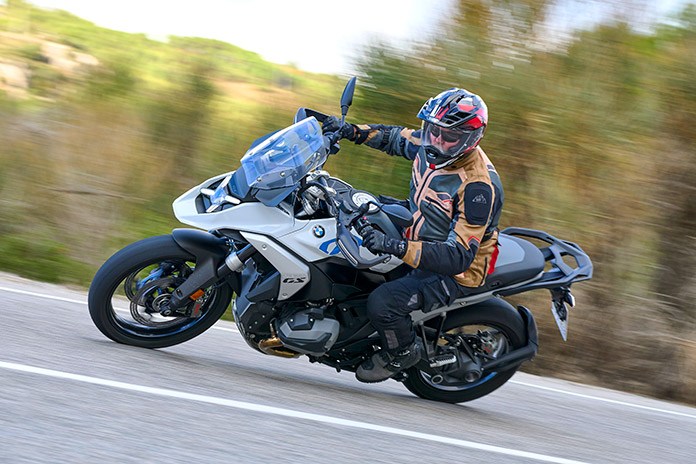
The added power and torque allow the R 1300 GS to launch forward quickly with a flick of the wrist in almost any gear or rpm, yet the bike doesn’t feel edgy or aggressive. The revamped boxer runs more smoothly, which long-distance touring riders will appreciate. Whether light pulls on the lever or hard squeezes, the GS slows down with precision and power, enhanced by the electronic wizardry of cornering ABS and semi-active suspension.
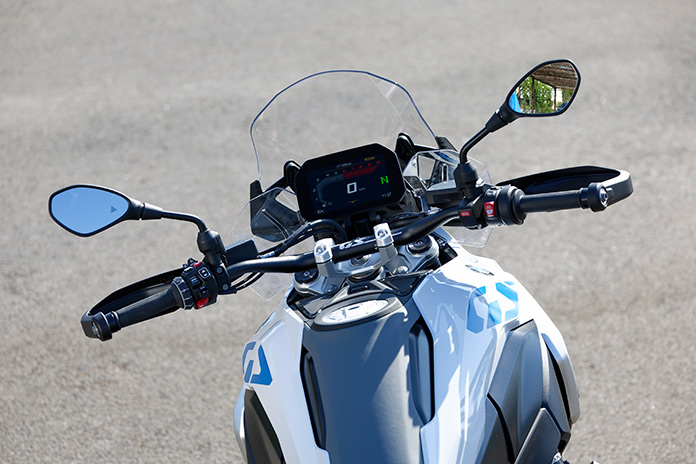
Not only does the new GS handle, accelerate, and stop better than the R 1250 GS, it’s also more comfortable. At 33.5 inches, its nonadjustable seat height is the same as the low position on the 1250. I’m 6-feet tall with long arms and a 34-inch inseam, and the ergonomics of R-series GS models have always suited me. The 1300’s taller handlebar opens up the rider triangle, which I found agreeable whether seated or standing. We tried two different windscreens, the short Sport windscreen and the electrically adjustable windscreen with side deflectors, and both managed airflow well, the latter providing more protection at any height.
BMW R 1300 GS: The Every Bike
State-of-the-art technology has always been an important aspect of the GS. The R 1300 GS has more standard features than before, including the electronic rider aids listed above along with a 6.5-inch TFT with connectivity, tire-pressure monitoring, heated grips, cruise control, handguards with integrated turnsignals, Keyless Ride, a 12V socket, and a smartphone charging compartment with a USB port.
Since the R 1300 GS is the continuation of its bestselling model line, BMW Motorrad tried to ensure that almost any customer preference will be satisfied. Four model variants are available:
- The base model R 1300 GS has a Sport windscreen and a 33.5-inch seat height, and it comes in Light White with a two-tone black/gray two-piece rider and passenger seat.
- The Triple Black variant has a black-on-black color scheme, an electric high windscreen with side wind deflectors, comfort seats, comfort passenger footpegs, and a centerstand.
- The Trophy variant has a red/white/blue Racing Blue Metallic colorway as well as a high rider’s seat (34.2 inches) and a Sport passenger seat that give the appearance of a one-piece rally seat.
- The Option 719 Tramuntana variant has an Aurelius Green Metallic paint scheme and special finishes, a gold anodized handlebar, cross-spoke wheels with gold rims, and a rear luggage rack.
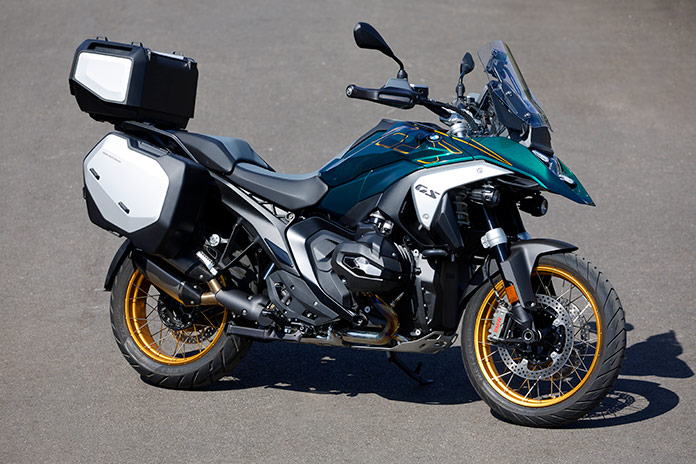
There are three options packages:
- The Premium Package adds lean-sensitive Headlight Pro, Dynamic Suspension Adjustment, Shift Assistant Pro, Riding Modes Pro, Sport Brakes, Central Locking, preparation for navigation, a chrome-plated exhaust manifold, Vario side and top case mounts, handguard extensions, and the new radar-enabled Riding Assistant, which includes Front Collision Warning, Active Cruise Control, and Lane Change Warning.
- The Comfort Package adds an electric high windscreen, a centerstand, a Comfort passenger seat and footpegs, and a luggage rack.
- The Enduro Pro Package adds handlebar risers, engine protection bars, an enduro aluminum engine guard, short enduro handlebar levers, GS adjustable rider footpegs, an exhaust mount for single seat, adjustable foot brake and gearshift levers, large frame guards, and narrower turnsignal stalks.
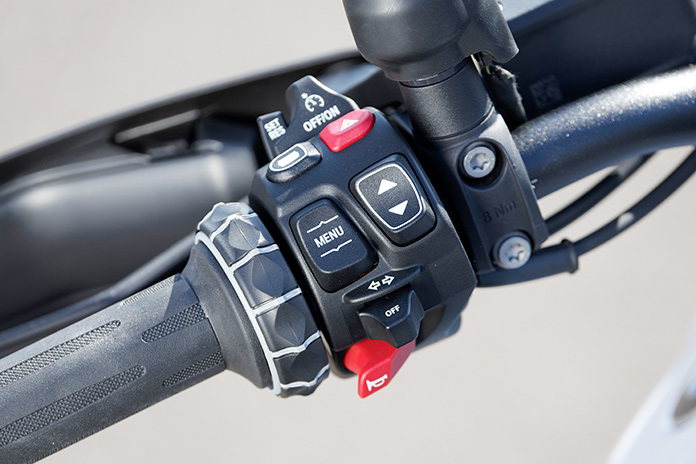
And there are more than 60 individual options and accessories. Depending on how the R 1300 GS is configured, there are seven seat heights to choose from ranging from 31.5 inches to 35 inches. There are four different suspension options to choose from: Series (manual adjustment), DSA (Dynamic Suspension Adjustment), DSA + Sport Suspension, and DSA + Adaptive Vehicle Height Control. There are different windscreens, footpegs, levers, protection bars and guards, wheels, and a dizzying array of luggage options.
By completely overhauling the R-series GS platform, BMW Motorrad risked alienating some of its core customers and possibly jeopardizing sales of its flagship motorcycle. But it’s also no surprise that the most powerful, capable, and sophisticated R-series GS made its debut during BMW Motorrad’s 100th anniversary. It’s the perfect motorcycle to carry the marque into its next century.
Check out more new motorcycles in Rider’s 2024 Motorcycle Buyers Guide.
2024 BMW R 1300 GS Specs
- Base Price: $18,895
- Warranty: 3 yrs., 36,000 miles
- Website: BMWMotorcycles.com
ENGINE
- Type: Air/oil-cooled, longitudinal opposed flat Twin, DOHC w/ 4 valves per cyl.
- Displacement: 1,300cc
- Bore x Stroke: 106.5 x 73.0mm
- Compression Ratio: 13.3:1
- Valve Insp. Interval: 12,000 miles
- Fuel Delivery: Fully sequential EFI, 52mm throttle bodies x 2
- Lubrication System: Wet sump, 4.2 qt. cap.
- Transmission: 6-speed, hydraulically actuated slip/assist wet clutch
- Final Drive: Shaft
CHASSIS
- Frame: Two-section sheet metal main frame w/ engine as stressed member, cast-aluminum subframe, single-sided cast-aluminum swingarm
- Wheelbase: 59.8 in.
- Rake/Trail: 26.2 degrees/4.4 in.
- Seat Height: 33.5 in.
- Suspension, Front: EVO Telelever w/ single shock, fully adj., 7.5 in. travel
- Rear: EVO Paralever w/ single shock, fully adj., 7.9 in. travel
- Brakes, Front: Dual 310mm floating discs w/ radial-mount opposed 4-piston calipers & ABS
- Rear: Single 285mm disc w/ floating 2-piston caliper & ABS
- Wheels, Front: Cast, 3.00 x 19 in.
- Rear: Cast, 4.50 x 17 in.
- Tires, Front: Tubeless, 120/70-ZR19
- Rear: Tubeless, 170/60-ZR17
- Wet Weight: 523 lb (factory claim)
- Load Capacity: 502 lb
- GVWR: 1,025 lb
PERFORMANCE
- Horsepower: 145 @ 7,750 rpm (factory claim)
- Torque: 105 lb-ft @ 6,500 rpm (factory claim)
- Fuel Capacity: 5.0 gal.
The post 2024 BMW R 1300 GS Review | First Ride appeared first on Rider Magazine.
]]>